AILET 2022 BA LLB Question paper with answer key pdf conducted on June 26 is available for download. The exam was successfully organized by Delhi National Law University. The question paper comprised a total of 150 questions divided among three sections.
AILET 2022 BA LLB Question Paper with Answer Key PDFs
| AILET 2022 BA LLB Question Paper with Solution PDF | Check Solution |
Select which of the following assumptions is the ruling of the Court is based on.
View Solution
Step 1: Understanding the Question:
The question asks to identify the underlying assumption on which the court's ruling is based. An assumption is a belief or idea that is taken for granted as true to form the basis of an argument.
Step 2: Analyzing the Passage:
The passage states that the use of filtering software is subject to "strict scrutiny." Strict scrutiny is the highest level of judicial review and is applied when a law or action infringes upon a fundamental constitutional right (like freedom of speech and access to information). For a measure to pass strict scrutiny, it must be proven to be the "least restrictive means" to achieve a "compelling government interest."
Step 3: Detailed Explanation:
The very fact that the court applies "strict scrutiny" implies that it considers filtering software to be a significant infringement on patrons' rights. The condition that "no less restrictive alternative would serve that interest" highlights the court's concern with the software's restrictive nature. The court is operating from the premise that this is a highly restrictive measure, which is why such a high legal standard is necessary to justify its use. If the software were not considered highly restrictive, a lower, less demanding standard of review would have been applied. Therefore, the assumption is that the software is a very restrictive tool. Option (B) captures this idea, suggesting it is the "most restrictive," which is the core reason for the stringent legal test.
Step 4: Final Answer:
The ruling applies "strict scrutiny," a test reserved for actions that significantly restrict fundamental rights. This indicates the court assumes that filtering software is a highly restrictive measure. Option (B) best reflects this foundational assumption.
Quick Tip: In legal comprehension passages, pay close attention to legal terms like "strict scrutiny." Understanding their implications can reveal the underlying assumptions of the court or author. "Strict scrutiny" always implies a high degree of restriction on rights.
What, according to the passage, is the primary purpose of filtering software within a public library?
View Solution
Step 1: Understanding the Question:
The question asks for the main reason or purpose for using filtering software in a public library, as stated in the provided text.
Step 2: Locating the Relevant Information:
The passage explicitly states the purposes of the filtering software in the second sentence: "...preventing patrons from accessing visual depictions of obscenity, or in the case of minors, material harmful to minors. Moreover, use of filters also helps to prevent patrons from being unwillingly exposed to patently offensive, content on the Internet."
Step 3: Detailed Explanation:
The text clearly identifies two main functions:
1. To stop patrons from viewing obscene or harmful material.
2. To protect patrons from accidentally seeing offensive content.
Both of these functions fall under the general category of preventing access to inappropriate content. Options (A), (B), and (C) are not mentioned in the text at all.
Step 4: Final Answer:
The passage directly states that the software's purpose is to prevent access to obscenity, material harmful to minors, and patently offensive content. Option (D) is a perfect summary of this purpose.
Quick Tip: For questions asking about the "primary purpose," look for direct statements in the text that explain the function or goal of the subject. Often, the answer is explicitly written and just needs to be identified.
Which of the following words is an antonym to the word "compelling" used in the text ?
View Solution
Step 1: Understanding the Question:
The question asks for the antonym (a word with the opposite meaning) of "compelling" as used in the phrase "compelling government interest."
Step 2: Defining the Word in Context:
In a legal context, a "compelling interest" refers to a reason or justification that is extremely strong, powerful, and convincing. It is a purpose of the highest order that can justify infringing upon fundamental rights.
Step 3: Evaluating the Options:
- (A) singular: means unique or one of a kind, not an opposite of strong.
- (B) strange: means unusual or odd, not an opposite of strong.
- (C) weak: means lacking power, force, or conviction. This is a direct opposite of compelling. A weak interest would not be enough to justify restricting rights.
- (D) popular: means liked by many people, which is different from being strong or convincing.
Step 4: Final Answer:
The opposite of a strong, powerful reason (compelling) is a powerless, unconvincing reason (weak). Therefore, "weak" is the correct antonym.
Quick Tip: When asked for an antonym or synonym, always consider the context in which the word is used in the passage. The same word can have different meanings in different contexts. Here, "compelling" is used in a legal sense, meaning "powerfully convincing."
INDIA’S MARINE EXPORTS REACH ALL TIME HIGH OF $ 7,740 MILLION
Vijayawada: Exports of marine products from India have reached an all-time high of US $ 7,740 million in 2021-22 against the targeted US $ 7,809 million fixed by the centre. Marine Products Exports Development Authority joint director A. Jeyabal in a statement here on Friday said India’s exports of marine products grew 30 percent compared to 2020-21 in value terms. The compound annual growth rate of seafood exports during the past decade has been 8.23 percent, he pointed out. Jeyabal explained that India exported marine products to 121 countries during 2021-22, the US 2 being the top destination with exports worth US $ 3,315 million in 2021-22 against the target of $ 3,021 million. China and Japan stood at number two and three positions respectively. All three top destinations of Indian marine exports constitute 63 percent of India’s exports in value terms.
Question 4:
The phrase "an all-time high" indicates that India's marine
Substitute the underlined phrase with the option closest in meaning.
"The compound annual growth rate of seafood exports during the past decade has been 8.23 percent, he pointed out."
Which of the following statements are true for the given text ?
(i) 2022 is fast becoming the most successful year for Indian exports, in terms of marine products.
(ii) The director of "Marine Products Exports Development Authority" is Mr. A. Jeyabal.
(iii) Mr. A. Jeyabal is sure that India will grow as an exporter of marine products.
(iv) There is most demand for India's marine products in the US.
The most appropriate by-line for the article would be
It can be inferred from the text that
Select the sentence that is the most appropriate conclusion for the given text.


By using the phrase "gives a glimpse into", the text suggests that On Being a Veterinarian Series
View Solution
Step 1: Understanding the Question:
The question asks for the meaning implied by the phrase "gives a glimpse into" in the description of the On Being a Veterinarian Series.
Step 2: Analyzing the Phrase and Context:
A "glimpse" is a brief look or a quick insight, not a comprehensive or exhaustive study. The description further clarifies the purpose: "...to help future veterinary doctors better prepare for the challenges of this career." This shows the book offers focused insights (salient features) aimed at preparation.
Step 3: Detailed Explanation:
- (A) is incorrect because "glimpse" suggests the opposite of "extensive knowledge."
- (B) is incorrect as this is the description for So, You Want to be a Veterinarian, not the On Being a Veterinarian Series.
- (C) is incorrect because the book is for veterinary students to prepare for their career, not a manual of health advice for practicing doctors.
- (D) correctly interprets "glimpse" as providing key ("salient") features. It aligns with the stated goal of preparing students for the "difficulties of their profession."
Step 4: Final Answer:
The phrase "gives a glimpse into" combined with the book's purpose indicates that it provides important, focused insights to help students prepare for their careers. Option (D) accurately reflects this.
Quick Tip: Pay attention to figurative language and idioms. "A glimpse" implies a brief but revealing view, not a complete one. Match this nuance with the options provided.
A 'small animal veterinarian' involves dealing with
View Solution
Step 1: Understanding the Question:
The question asks for the definition of a "small animal veterinarian." This is a vocabulary and general knowledge question based on the text.
Step 2: Defining the Term:
In veterinary medicine, the profession is often categorized by the types of animals treated. "Large animal" or "livestock" vets typically treat farm animals like cows and horses. "Exotic animal" vets treat zoo or non-domesticated animals. A "small animal veterinarian" is the common term for a vet who treats domestic pets.
Step 3: Detailed Explanation:
- (A) Farm animals are treated by large animal vets.
- (B) Companion animals, such as dogs, cats, rabbits, and other household pets, are the primary patients of a small animal veterinarian.
- (C) Zoo animals are treated by specialized exotic or zoo veterinarians.
- (D) Endangered animals may be treated by wildlife or zoo veterinarians, not typically in a small animal practice.
Step 4: Final Answer:
The term 'small animal veterinarian' refers to a professional who treats companion animals or pets.
Quick Tip: Some questions in reading comprehension passages test your general knowledge of the subject matter. "Small animal vet" is a standard industry term for a pet doctor.
Which underlined phrase is similar in meaning to "increases the odds of success" ?
(So, You Want to be a Veterinarian)
View Solution
Step 1: Understanding the Question:
The question asks to find the phrase that is closest in meaning to "increases the odds of success."
Step 2: Analyzing the Original Phrase:
"Increases the odds of success" means to make it more likely that one will succeed or achieve a desired outcome. It's about improving probability.
Step 3: Detailed Explanation:
- (A) This describes a state of maximum chance, not the act of increasing the chance.
- (B) This uses the literal meaning of "bets" and "victory," which is not the same as the figurative "odds of success" in an academic or professional context.
- (C) "Improves its chances of surging ahead" is a direct parallel. "Improves its chances" is synonymous with "increases the odds," and "surging ahead" is a form of "success." The context is different (business vs. admissions), but the meaning is the same.
- (D) This suggests a method for success but doesn't contain a phrase synonymous with increasing the likelihood of it.
Step 4: Final Answer:
The phrase in option (C) is the most analogous in structure and meaning to the original phrase. Both refer to actions that make a positive outcome more probable.
Quick Tip: For "similar meaning" questions, look for a phrase that has the same core idea, even if it's used in a different context. The key concepts here are "increase," "probability," and "success."
Select the option that correctly displays the meaning of 'succinctly' as used in the given line, from the text about So, You Want to be a Veterinarian.
'It succinctly describes colleges of veterinary medicine...'
View Solution
Step 1: Understanding the Question:
The question asks for the correct meaning of the word "succinctly."
Step 2: Defining 'Succinctly':
"Succinctly" means expressing something clearly in a few words; it implies being both brief and clear. Synonyms include concise, brief, compact, condensed, and to the point.
Step 3: Evaluating the Options:
- We need to find the option where all words are synonyms or closely related meanings of "succinctly."
- Options (B) and (D) contain the word "discursive," which means digressing from subject to subject. This is the opposite of succinct.
- Option (A) contains "polite," which is unrelated to the meaning of being brief and clear.
- Option (C) contains "condensed," "compact," "brief," and "to the point," all of which are excellent synonyms for "succinctly."
Step 4: Final Answer:
Option (C) provides a list of words that accurately define the meaning of "succinctly."
Quick Tip: In multiple-choice definition questions, use the process of elimination. A single incorrect word in an option makes the entire option wrong. Here, "discursive" is a key antonym that helps eliminate two choices.
Which book/s of the three mentioned in the text is/are like to include the following line ?
How long it takes to become a vet can vary, but if you really love animals and think caring for them is up your alley, then becoming a veterinarian may be the right choice for you.
View Solution
Step 1: Understanding the Question:
The question asks us to identify which of the three books would most likely contain the given sentence.
Step 2: Analyzing the Sentence's Tone and Content:
The sentence is motivational and advisory. It addresses someone considering the veterinary profession ("the right choice for you"). It uses informal language ("up your alley") but also touches on a practical aspect ("How long it takes... can vary").
Step 3: Matching the Sentence to the Books:
- I Want to be a Veterinarian: This is a "Level One I Can Read" book for young children. The sentence structure and vocabulary are likely too advanced for its target audience.
- So, You Want to be a Veterinarian: This book is for "aspiring veterinarians" and describes the profession and admission process. The sentence fits perfectly as an introduction to encourage and guide potential applicants.
- On Being a Veterinarian Series: This book is for "pre-vet and veterinary students" to prepare them for the "challenges of this career." The motivational and advisory tone of the sentence also fits this book, as it speaks to those already on the path.
Step 4: Final Answer:
The sentence is too complex for the children's book. However, its encouraging and guiding tone is suitable for both the book aimed at aspiring vets considering the career (So, You Want to be a Veterinarian) and the one for students already in the field preparing for its realities (On Being a Veterinarian). Therefore, option (A) is the most appropriate choice.
Quick Tip: To match a quote to a text, analyze the tone, vocabulary, and target audience. The informal yet serious tone of the quote fits well with materials designed for young adults and students considering a career.
Which topic would be a part of 'disciplinary specialities' in So, You Want to be a Veterinarian?
View Solution
Step 1: Understanding the Question:
The question asks to identify which of the options is an example of a "disciplinary specialty" within the veterinary profession.
Step 2: Defining 'Disciplinary Specialty':
In any profession, a "disciplinary specialty" refers to a specific area of expertise or field of study within the broader discipline. Examples in human medicine would be cardiology, neurology, or pediatrics. We are looking for a similar specialized field within veterinary medicine.
Step 3: Evaluating the Options:
- (A) Remount and Veterinary Corps is a branch of the military, which is an employment sector, not a field of study.
- (B) Internship allowance is related to salary or financial compensation, not a medical specialty.
- (C) International Institute of Veterinary Education \& Research is an educational institution, not a specialty.
- (D) Sports medicine and rehabilitation is a specific area of practice focusing on athletic animals, which is a recognized specialty in veterinary medicine (e.g., for racehorses or canine athletes).
Step 4: Final Answer:
"Sports medicine and rehabilitation" is a specific field of practice within veterinary medicine and is therefore a disciplinary specialty.
Quick Tip: Distinguish between a field of study (specialty), a place of employment (industry, government), an institution (college), and a financial aspect (allowance). A specialty is a specific area of knowledge and practice.
Upon reading the passage, which of the following is likely to be inferred about the main aim of I Want to be a Veterinarian?
View Solution
Step 1: Understanding the Question:
The question asks for the main goal or primary purpose of the book I Want to be a Veterinarian.
Step 2: Analyzing the Book's Description:
The description heavily emphasizes its role as a literacy tool. Key phrases include: "part of a new I Can Read series," "Level One I Can Read is perfect for children learning to sound out words and sentences," and "support success for children eager to start reading on their own."
Step 3: Detailed Explanation:
While the book is about veterinarians (a community helper) and features diverse characters, these are secondary features. The primary, explicitly stated purpose is to help children learn to read.
- (A), (B), and (C) are topics or features of the book, but they are the vehicle for the main aim.
- (D) directly states the core educational goal of the "I Can Read" series: helping children learn to "start reading on their own."
Step 4: Final Answer:
The description makes it clear that the book's main purpose is to function as an early reading tool. Therefore, the primary aim is to help children learn to read by themselves.
Quick Tip: To find the "main aim" of a product or text, look for statements that describe its fundamental purpose or the series it belongs to. The name "I Can Read series" is a major clue to the book's primary goal.
Select the option that matches the books to the most likely readerships, according to the text. Choose three appropriate options from out of four options given.

View Solution
Step 1: Understanding the Question:
The question requires matching each of the three books (A, B, C) with its correct target audience (i, ii, iii, or iv) based on the descriptions provided.
Step 2: Matching Each Book to its Readership:
- A. I Want to be a Veterinarian: The text says it's for "young readers" and "children learning to sound out words." This clearly matches (ii) children.
- B. So, You Want to be a Veterinarian: The text describes this as "suggested reading for aspiring veterinarians" and discusses "colleges" and "admission requirements." This audience would be high school or undergraduate students, which corresponds to (i) school students/ graduates.
- C. On Being a Veterinarian Series: The text specifies that this series "gives pre-vet and veterinary students a glimpse into what it's really like." This directly matches (iii) pre-vet and veterinary students.
Step 3: Assembling the Correct Combination:
The correct pairings are:
- A -\(>\) ii
- B -\(>\) i
- C -\(>\) iii
This combination is presented in option (C).
Step 4: Final Answer:
Based on a direct reading of the text, the correct matches are A-(ii), B-(i), and C-(iii).
Quick Tip: In matching questions, go through each item one by one and find its explicit partner in the text. Write down the pairs before looking at the options to avoid confusion.
THE SCARF JOINT
The method known as ”scarfing” is used for the joining of timber in the direction of its length, enabling the workman to produce a joint with a smooth or flush appearance on all its faces. One of the simplest forms of scarfed joint is known as the half lap, in which a portion is cut out at the end of each beam or joist, equal in depth to half the full depth of the beam, and of equal length to the required scarf. The two pieces, before they are placed together, form a joint with the projecting part fitting into the recessed portion and the two pieces being secured in their respective positions by screws. A tabled scarf joint is very easy to make and fit, and is not materially affected by shrinkage. Rectangular wrought iron straps are knocked up over the joint after the two pieces engage. A lapped scarf joint is secured with nuts and bolts and effectively resists compressional stress in vertical posts.
THE PUZZLE JOINTS
These are not only interesting in themselves, but are often excellent studies in craftsmanship. The majority of them, if to be satisfactory as puzzles, call for very careful setting out and cutting, entailing the same degree of skill that is demanded for high-class cabinet work. For this reason, several illustrations of examples may well find a place in a volume dealing with woodwork joints. As a rule, these puzzles should be made in hardwood, such as dark walnut or beech, as in whitewood the joints are soon liable to wear.
Question 18:
Ensuring the 'flush appearance on all its faces' refers to the
Which option includes the correct meaning of the underlined phrase in the given sentence ?
Rectangular wrought iron straps are knocked up over the joint after the two pieces engage.
Select the reason why several illustrations of puzzle joint examples are often showcased in a volume dealing with woodwork joints.
Choose the correct order of the following statements in the passage.
(i) The workman cuts out a portion at the end of each beam or joist.
(ii) The two pieces are placed together to form a joint.
(iii) The two pieces are secured in their respective positions by screws.
(iv) The workman measures out a portion in the beam that is equal in depth to half the full depth of the beam, and of equal length to the required scarf.
Which quality makes hardwood the choice for puzzle joints ?
LAWRENCE RUBIN:
Hi, Jessica. Thanks for joining me today. How did you become interested in digital play therapy, which really is cutting-edge and somewhat controversial with children?
JESSICA STONE:
I am a licensed psychologist with a specialty in play therapy. Within it, digital play therapy has become one of those areas of interest over the last 20 years, stemming from experiences with my own kids, who had this whole portion of their world that I didn’t really understand, know about, or enter into. It struck me as a little bit ironic and maybe even hypocritical that here I spend my time at work and my energy in learning and doing play therapy with children and entering their world, while my own kids have this whole portion of theirs that I was putting no effort into understanding. And so, I kind of had to smack myself upside the head and say, all right, I need to learn more about this. Why is this important to them? Why are they interested in it ? Long story short, I ended up entering an online game that my oldest two (of four children) were both playing at the time. I am no digital native by any means, and I was not very good at these games, but the point was that I was taking interest. I was listening to them. I was asking them questions. We were having conversations about what happened in the game, what quest they were working on; things that were important to them that prior to my entering their world, I couldn’t participate in or even understand. I began to see that because this co-play was so impactful with my own children, I needed to incorporate it into my work, which really opened the door to what I have been doing for all these years.
LAWRENCE RUBIN:
So, you recognized that technology was so important and present in your kids’ life that you would be almost doing a disservice to your young clients if you didn’t cross that bridge into their digital world. Tell me, what exactly is digital play therapy ?
JESSICA STONE:
Digital play therapy is a modality that is based in speaking the client’s language through what I call the four C’s, which are competency, culture, comfort, and capability. These are basic elements of therapy in general, but digital play therapy in particular is couched within the broader context of prescriptive play therapy, which taps into what Charles Schaefer calls the therapeutic powers of play. So, the point is that there is a foundation for it. It’s not just, oh, let’s just jump on this bandwagon and start throwing these digital things into what we’re doing. We as clinicians need to have a very firm and solid foundation in what it is we’re doing and why we’re doing it regardless of our theoretical foundation, therapeutic modality, and interventions, or whether the platform is virtual or face-to-face. And as in all therapies, we must ground our interventions in solid case conceptualization and treatment planning.
Question 23:
What is the primary purpose of this passage?
What is the tone conveyed by the speaker when she states - "... I kind of had to smack myself upside the head..."?
In the line, "...you would be almost doing a disservice to your young clients...", the word 'disservice' refers to being
How was Jessica Stone impacted by an online game ?
What does the interviewee mean when she says "I am no digital native" ?
Which skill does the interviewee display with the usage of the phrase, "Long story short"?
Which of these options best describes the expression "jump on this bandwagon"?
Which of the following is the least likely inference to be drawn from the given passage?
What does the phrase 'speaking the client's language' refer to, in the text ?
(Digital play therapy is a modality that is based in speaking the client's language...)
What is Jessica Stone's opinion on "digital play therapy" as per the text ?
Passage VI
Down in rain-swept Wiltshire last week, I was able to enjoy a Christmas tree, Christmas crackers, mistletoe, etc. I was able to sing carols and wish everyone I met a happy Christmas. In America, it seems, I’d have been outlawed if I’d attempted any such thing. According to Andrew Stephen in the New Statesman, Americans have become so desperate not to offend religious minorities that Christmas in America is now most definitely not politically correct and, in some cases, literally illegal.
In Kentucky, for example, school bus drivers were warned on no account to say ”Merry Christmas” to children getting on or off their buses. In Philadelphia, you are breaking the law, says Stephen, ”if you have a Christmas tree in your home - you may be subject to a $300 fine”. A nursery school teacher in Washington, he goes on, has temporarily removed the ”t” from the letters of the alphabet that she has strung around the classroom: ”It looked a bit too much like a cross for comfort”. Oh, and schools in Scarsdale, New York ”have banned the American tradition of ”candy canes”, striped mint sweets in the shape of walking sticks; they could be construed as shepherds’ crooks, you see, and we all know what that means at the time of the year”.
My Christmas in Wiltshire may have been wet but at least it felt like a real Christmas and not like this kind of anodyne travesty, disinfected of all reference to what the holiday is about.
Question 33:
Which of the statements do you think does not support the author's idea in the passage?
The last sentence in the passage conveys that the writer :
View Solution
Step 1: Understanding the Question:
The question asks for the meaning conveyed by the final sentence of the passage.
Step 2: Analyzing the Last Sentence:
The last sentence is: "My Christmas in Wiltshire may have been wet but at least it felt like a real Christmas and not like this kind of anodyne travesty, disinfected of all reference to what the holiday is about."
Step 3: Detailed Explanation:
The author contrasts his experience in Wiltshire with the situation in America.
- "My Christmas in Wiltshire may have been wet but at least it felt like a real Christmas..." - This phrase shows his satisfaction and contentment with his experience, despite the bad weather. He values its authenticity.
- "...and not like this kind of anodyne travesty..." - He uses strong negative words ("anodyne," "travesty") to describe the American Christmas he has been reading about, showing clear disapproval.
- Let's evaluate the options based on this analysis:
(A) The author clearly disapproves of the American approach, so this is incorrect.
(B) The author uses Andrew Stephen's account to support his own argument. He agrees with Stephen, not disagrees. So, this is incorrect.
(C) The phrase "at least it felt like a real Christmas" directly expresses his contentment with his experience in Wiltshire, making this the correct choice.
(D) The author's focus is on the overcorrection by the majority, not on expressing sympathy for the minorities. His tone is critical of the outcome, not empathetic towards the cause. So, this is incorrect.
Step 4: Final Answer:
The last sentence clearly conveys the writer's contentment with the "real" Christmas he experienced in Wiltshire.
Quick Tip: Pay close attention to contrasting words like "but," "at least," or "unlike." They often signal the author's preference or main point in a concluding sentence.
Which of the following words from the passage, most closely resemble the meaning "anodyne" and "construed" ?
View Solution
Step 1: Understanding the Question:
The question asks for the best synonyms for the words "anodyne" and "construed" from the given options.
Step 2: Defining the Words:
- Anodyne: In the context "anodyne travesty," it means something that is deliberately inoffensive, bland, or unlikely to cause controversy. It's something made harmless or weak.
- Construed: In the context "they could be construed as shepherds' crooks," it means to interpret a word or action in a particular way.
Step 3: Evaluating the Options:
(A) pernicious (harmful), blatant (obvious) - Incorrect meanings.
(B) jilted (rejected), misinterpreted - "Misinterpreted" is close to "construed," but it implies a wrong interpretation, which is not necessary. "Jilted" is completely unrelated to "anodyne."
(C) unobjectionable (not open to objection; acceptable), interpreted - "Unobjectionable" is a very close synonym for "anodyne" in this context, meaning made so as not to offend. "Interpreted" is a direct synonym for "construed." This is the best fit.
(D) menacing (threatening), unequivocal (unambiguous) - Incorrect meanings.
Step 4: Final Answer:
The pair "unobjectionable, interpreted" most closely matches the meanings of "anodyne" and "construed."
Quick Tip: When faced with vocabulary questions based on a passage, always re-read the sentence where the word is used. The context provides crucial clues to its precise meaning.
What parts of speech do the words 'religious', 'travesty' and 'temporarily' belong to ?
View Solution
Step 1: Understanding the Question:
The question asks to identify the correct part of speech for each of the three words: 'religious', 'travesty', and 'temporarily'.
Step 2: Detailed Explanation:
1. religious: This word is used in the phrase "religious minorities." It describes the noun "minorities." A word that describes or modifies a noun is an adjective.
2. travesty: This word is used in the phrase "anodyne travesty." It is a thing—a distorted or absurd representation of something. A word that names a person, place, thing, or idea is a noun.
3. temporarily: This word is used in the phrase "has temporarily removed the 't'." It describes how the action of removing was done (the verb "removed"). A word that modifies a verb, adjective, or another adverb is an adverb.
Step 3: Matching with Options:
The correct sequence of parts of speech is Adjective, Noun, Adverb. This corresponds to option (A).
Step 4: Final Answer:
The correct parts of speech are adjective for 'religious', noun for 'travesty', and adverb for 'temporarily'.
Quick Tip: To identify a part of speech, look at the word's function in the sentence. Does it describe a noun (adjective)? Is it a thing or concept (noun)? Does it describe an action or a quality (adverb)? The suffix "-ly" often indicates an adverb.
Which of the following is the most appropriate title for the passage?
View Solution
Step 1: Understanding the Question:
The question asks for the most suitable title that captures the central theme and tone of the passage.
Step 2: Analyzing the Passage's Theme and Tone:
The passage describes how Christmas traditions in America are being suppressed and even made "literally illegal" out of a "desperate" fear of offending minorities. The author uses strong, negative language like "outlawed," "breaking the law," "travesty," and "disinfected." The tone is not neutral; it's critical and somewhat alarmist.
Step 3: Evaluating the Options:
(A) Abolishing Christmas: While hyperbolic, this title captures the author's strong sense that the fundamental nature of Christmas is being systematically erased or "abolished." Given the examples of making traditions illegal, it aligns with the passage's critical and extreme tone.
(B) Christmas past and present: This is too general and neutral. The passage is not a simple comparison but a strong critique of the present situation in a specific place (America).
(C) The everchanging tradition of Christmas: This title is also too neutral. The author isn't just observing change; he is decrying it as a negative "travesty."
(D) Transcending beliefs: This title suggests a positive theme of rising above religious differences, which is the opposite of the author's point. The author believes the attempt to do this has failed and ruined the holiday.
Step 4: Final Answer:
"Abolishing Christmas" best reflects the author's critical tone and the severity of the situation as he portrays it.
Quick Tip: When choosing a title, consider both the topic and the author's tone. A good title reflects not just what the passage is about, but also the author's perspective (e.g., critical, neutral, supportive).
Passage VII
Economic historians have argued that the Industrial Revolution in Britain could not have occurred without the capital that became available from the plunder of India. The sudden acceleration of the revolution in Britain, R. P. Dutt points out, coincides with the establishment of British rule in India. He writes, ”In 1757 came the Battle of Plassey and the wealth of India began to flood the country in an ever-growing stream... in 1764 came the spinning jenny of Hargreaves; in 1765 came Watt’s steam engine, patented in 1769; in 1769 came the water frame of Arkwright followed by his patents in 1775 for carding, drawing and spinning machines; in 1779 the mule of Crompton and 1785 the power loom of Cartwright; and in 1788 the steam engine was applied to blast furnaces.” These inventions, Dutt argues, did not result from some ”special and unaccountable burst of inventive genius,” but from the accumulation of enough capital to make possible the largescale outlay needed to turn the inventions into functional fortunes.
Contemporary accounts attest to the devastation that followed in India. ”This fine country,” one of the East India’s own residents reported, ”which flourished under the most despotic and arbitrary government is verging towards ruin.” Francis Buchanan, who surveyed the country in the early 1800s, wrote: ”The natives allege that, although they were often squeezed by the Mogul officers, and on all occasions were treated with utmost contempt, they preferred suffering these evils to the mode that has been adopted of selling their lands when they fall in arrears, which is a practice they cannot endure. Besides, bribery went a great way on most occasions, and they allege that, bribes included, they did not actually pay one half of what they do now.” Both agricultural self-sufficiency and what by many accounts was a growing industrial economy were broken down. For the peasant, insecurity, impoverishment, and indebtedness followed. The shadow of famine stalked the next century. The new system of land taxes introduced with the Permanent Settlement of 1793 turned the zamindars, who were originally tax collectors, into landowners with new rights to evict the peasants who cultivated the lands for not paying the revenues.
Question 38:
According to the passage, which of the options accelerated the burst of inventive genius in Britain?
Which could be the prime attributing factor responsible for the disintegration of the Indian economy ?
View Solution
Step 1: Understanding the Question:
The question asks for the primary factor(s) that led to the breakdown of the Indian economy as described in the passage.
Step 2: Identifying Key Factors from the Passage:
The passage describes several interconnected problems that followed British rule:
- "Both agricultural self-sufficiency and what by many accounts was a growing industrial economy were broken down."
- "For the peasant, insecurity, impoverishment, and indebtedness followed." This covers options (A) and (B).
- The passage also states that the natives preferred the problems under the Moguls to the new British system, indicating the new system was even worse. The new system of selling lands for arrears and higher payments ("they did not actually pay one half of what they do now") led to the disintegration. While not Mogul atrocities themselves, the comparison highlights the severity of the new plight, which built upon existing structures. The "plight" was made worse by the British.
Step 3: Evaluating the Options:
(A) "growing indebtedness among the farmer fraternity" is explicitly mentioned.
(B) "Widespread penury among the masses" (penury means extreme poverty) is a direct consequence mentioned ("impoverishment").
(C) "The plight of those who were still reeling under the Mogul atrocities" is indirectly supported. The passage makes it clear the British system was even worse than the Mogul system, exacerbating the suffering of the people.
Given that (A) and (B) are direct results of the British policies described, and these policies were considered worse than the previous regime's, all these factors collectively describe the disintegration of the economy. Therefore, "All of the above" is the most comprehensive answer.
Step 4: Final Answer:
The disintegration of the Indian economy was a complex issue resulting from multiple factors, including peasant indebtedness, widespread poverty, and a new, oppressive system of land revenue, all of which are mentioned or alluded to in the passage.
Quick Tip: When an "All of the above" option is present, carefully check if more than one of the other options is supported by the text. If you can confirm at least two are correct, "All of the above" is likely the intended answer.
The first paragraph is a fine example of
View Solution
Step 1: Understanding the Question:
The question asks to categorize the style or content of the first paragraph.
Step 2: Analyzing the First Paragraph:
The paragraph lists a sequence of events with their specific years:
- "In 1757 came the Battle of Plassey..."
- "...in 1764 came the spinning jenny..."
- "...in 1765 came Watt's steam engine, patented in 1769..."
- "...in 1769 came the water frame of Arkwright..."
- "...in 1779 the mule of Crompton and 1785 the power loom..."
This method of listing events in the order they occurred is a clear presentation of chronological data.
Step 3: Evaluating the Options:
(A) Oral histories are based on spoken accounts, not a written list of dates and inventions.
(B) Review writing involves evaluating or assessing something, which is not the primary function here.
(C) Chronological data refers to information arranged in order of time. This perfectly describes the structure of the paragraph.
(D) Journal jottings are typically personal, informal notes, which doesn't fit the formal, historical tone of the paragraph.
Step 4: Final Answer:
The first paragraph is a prime example of presenting chronological data to support an argument.
Quick Tip: Look for organizational patterns in paragraphs. The presence of multiple dates arranged in sequence is a strong clue for "chronological order" or "chronological data."
After the Permanent Settlement of 1793, the turn of events led to
View Solution
Step 1: Understanding the Question:
The question asks for the specific outcome of the Permanent Settlement of 1793 as described in the passage.
Step 2: Locating Relevant Information:
The answer is found in the very last sentence of the passage: "The new system of land taxes introduced with the Permanent Settlement of 1793 turned the zamindars, who were originally tax collectors, into landowners with new rights to evict the peasants who cultivated the lands for not paying the revenues."
Step 3: Detailed Explanation:
This sentence explicitly states that the zamindars, who were previously just tax collectors, were made into legal landowners by the new system.
- Option (A) is partially true but not the core change. The core change was their legal status.
- Option (B) directly captures this core change: the zamindars became legal landowners.
- Option (C) is incorrect; the passage distinguishes between the previous Mogul officers and the new system under the British.
- Option (D), while a consequence of the overall economic devastation, is not the direct legal change brought about by the Permanent Settlement itself. The change in land ownership was the direct event.
Step 4: Final Answer:
The Permanent Settlement of 1793 legally transformed zamindars from tax collectors into landowners.
Quick Tip: For questions that mention a specific term, date, or event from the passage (like "Permanent Settlement of 1793"), scan the text to find that exact phrase. The answer is usually in the same sentence or the one immediately following it.
The passage could probably be an excerpt from
View Solution
Step 1: Understanding the Question:
The question asks to identify the most likely source or context from which this passage was taken.
Step 2: Analyzing the Passage's Content and Perspective:
The passage does more than just list economic facts. It presents a strong, critical argument about British colonialism. Its central thesis is that Britain's prosperity (Industrial Revolution) was built on the "plunder of India," which led to India's "devastation" and "ruin."
Step 3: Evaluating the Options:
(A) An economic report might be more neutral and data-focused. While this passage uses economic data, its perspective is highly critical and narrative-driven, using strong words like "plunder" and "devastation."
(B) The economic critique of British rule, particularly the "drain of wealth" theory, was a fundamental ideological pillar of the Indian national movement. Leaders and writers of the movement frequently used such arguments to build a case for independence by highlighting the exploitative nature of colonialism. The passage's tone and argument fit perfectly within the literature of the national movement.
(C) A memoir is a personal account or autobiography. This passage is written in a formal, historical style, not a personal one.
(D) A scientific abstract is a brief summary of a scientific research paper, which is completely irrelevant to the topic.
Step 4: Final Answer:
Given its strong anti-colonial economic argument, the passage is most likely an excerpt from a text related to the Indian national movement.
Quick Tip: To determine the source of a passage, analyze its purpose and perspective. Is it just informing (like a report), or is it trying to persuade or argue a particular point of view (like political or historical commentary)? The latter is often the case in passages like this.
Passage VIII
The news made me very happy indeed. I would be married. There would be music, I would hear the women ululating. How exciting that would be! Yet I felt scared at the same time. I cannot express the apprehensions that came to my mind. Meanwhile, the various things necessary for the ceremony began to arrive. Relatives and guests began pouring in. I was scared to death by all this. I did not talk to anyone but spent most of the time weeping. Everybody did their best to reassure me. They embraced me, but the unspoken agony in my mind did not lift.
Later on, I was cheered up by the ornaments, the red wedding sari and the wedding music. I forgot my earlier worries and went about laughing and watching the elaborate preparations. My happiness knew no bounds. When everything was over the next day, I heard people asking my mother, ”Are they leaving today?” I thought they were referring to the guests. Then the music started. There was an air of festivity. The guests must be leaving now, I thought. It made me happy and I went about following my mother. Presently everybody assembled in the house. Some looked happy, but others were in tears. They made me really frightened. Then my brothers, aunts, uncles, and my mother all took me in their arms by turn as they burst into tears. Their tears made me so sad that I began to cry too. I knew my mother was going to hand me to the other family. I tightened my hold on her and pleaded, ”Don’t give me over to them, Mother!” that made everybody present even more upset. They broke down and tried to say nice words to console me. My mother took me in her arms and said, ”You are a good girl, you understand everything, don’t you?” God is with us; you needn’t be afraid. You are going to come back to us in a few days’ time. Every girl has to go to her in-laws’ house. Nobody else cries like this. There is no reason to be upset. Please calm down and talk to me.” But I was trembling with fear. I was quite unable to speak. Somehow, I managed to say through my tears: ”are you sure that God will go with me ?” Mother promptly reassured me that he most certainly would. ”He will be with you all the time, so stop crying now.” But in spite of her soothing words my apprehensions kept growing and I could not check my tears.
Question 43:
In the passage, the people ask the narrator's mother, "Are they leaving today?" Who are 'they' according to the narrator and the passage?
The women 'ululating' in the passage refers to them
View Solution
Step 1: Understanding the Question:
The question asks for the meaning of the word 'ululating' as used in the passage.
Step 2: Analyzing the Context:
The narrator says, "There would be music, I would hear the women ululating. How exciting that would be!" The word is associated with music and excitement, indicating a sound of celebration and happiness (mirth).
Step 3: Defining 'Ululating' and Evaluating Options:
'Ululating' is a high-pitched, wavering vocal sound produced by moving the tongue rapidly. It is a common practice in many cultures to express joy, especially during weddings and other festivities.
(A) Shedding tears is a physical action of crying, not a specific vocal sound.
(B) Wailing typically implies grief or sorrow, which contradicts the "exciting" context.
(C) "Loud sounds expressing mirth" (mirth means joy or happiness) accurately describes ululation in a celebratory context.
(D) While done during celebrations, ululation is a non-verbal sound of joy, not the speaking of specific blessings.
Step 4: Final Answer:
Based on the context and the definition of the word, 'ululating' refers to making loud, joyful sounds.
Quick Tip: When you encounter an unfamiliar word, use context clues. The words surrounding it (like "music" and "exciting") can help you infer its meaning and emotional connotation (positive or negative).
The tone and mood of the passage is
View Solution
Step 1: Understanding the Question:
The question asks to identify the overall tone (author's attitude) and mood (the feeling it evokes in the reader) of the passage.
Step 2: Detailed Explanation:
The passage describes a rollercoaster of feelings. The narrator experiences moments of extreme happiness ("My happiness knew no bounds") but these are overshadowed by intense fear, sadness, and anxiety ("scared to death," "unspoken agony," "burst into tears," "trembling with fear"). The central conflict is the narrator's deep sorrow and fear about leaving her family. The mother's attempts to console her fail, and the passage ends with "my apprehensions kept growing and I could not check my tears."
This strong focus on sadness, fear, and the pain of separation makes the passage deeply emotional. The final, unresolved sadness creates a depressing mood.
Step 3: Evaluating the Options:
(A) Depressing and emotional: This pair accurately captures the dominant feelings of sadness and the intense expression of feelings throughout the passage.
(B) Satirical and depressed: There is no satire (use of humor, irony, or exaggeration to criticize).
(C) Introspective and empathetic: While the passage is introspective (focused on inner thoughts), the dominant mood it creates is stronger than just introspection; it's actively sorrowful.
(D) Vitriolic and reassuring: There is no vitriol (bitter criticism). The reassurance offered by the mother is a key element, but it is ineffective and does not define the overall tone.
Step 4: Final Answer:
The passage's focus on the narrator's intense inner turmoil and sorrow makes its tone and mood depressing and emotional.
Quick Tip: The mood of a passage is often determined by the final sentences. A story that ends on a note of unresolved sadness or fear will likely have a depressing or melancholic mood.
Give the appropriate antonyms for: elaborate, agony and apprehension.
View Solution
Step 1: Understanding the Question:
The question requires finding the correct set of antonyms (words with opposite meanings) for the three given words: elaborate, agony, and apprehension.
Step 2: Defining the words and finding their opposites:
1. Elaborate: Means detailed, complex, or intricate. The opposite would be simple, basic, or plain.
2. Agony: Means extreme physical or mental pain/suffering. The opposite would be comfort, peace, or solace (comfort in sorrow).
3. Apprehension: Means anxiety or fear about the future. The opposite would be calmness, tranquility, or repose (a state of rest and peace).
Step 3: Evaluating the Options:
(A) basic (correct), assuagement (correct), solicitude (incorrect - means care/concern).
(B) embellished (synonym), anguish (synonym), dismay (related feeling, not an antonym).
(C) plain (correct), solace (correct), repose (correct). All three words in this option are appropriate antonyms.
(D) baroque (synonym), distress (synonym), inapprehension (not a standard word).
Step 4: Final Answer:
The set of words in option (C) provides the most accurate antonyms for elaborate, agony, and apprehension.
Quick Tip: When solving antonym/synonym questions with multiple words, use the process of elimination. Even if you are unsure about one word, you can often find the correct answer by identifying clear mismatches in the other pairs.
Identify the type of sentence: "You are a good girl, you understand everything, don't you ?"
View Solution
Step 1: Understanding the Question:
The question asks to classify the given sentence based on its grammatical structure.
Step 2: Key Concept: Sentence Types
- Tag Question: A statement followed by a short interrogative phrase (a "tag"). The tag seeks confirmation. For example, "It's a nice day, isn't it?"
- Interrogative Statement: A sentence that asks a direct question and ends with a question mark.
- Imperative Statement: A sentence that gives a command or makes a request. A negative imperative often starts with "Don't".
- Echo Question: A question that repeats part or all of what someone else has said, usually to express surprise or ask for clarification.
Step 3: Detailed Explanation:
The sentence "You are a good girl, you understand everything, don't you?" consists of two parts:
1. A declarative statement: "You are a good girl, you understand everything"
2. A short question or "tag" at the end: "don't you?"
This structure perfectly matches the definition of a tag question. It is used to seek agreement or confirmation from the listener.
Step 4: Final Answer:
The given sentence is a classic example of a tag question.
Quick Tip: A key feature of a tag question is the "statement + short question" structure. The tag is usually the opposite of the statement in terms of positive/negative form (e.g., positive statement, negative tag: "You are coming, aren't you?").
Passage IX
What colors can animals see? Is the world more brightly colored or duller to animals than it is to us? To find out the answers to these questions scientists have used a method of training the animals to come to different colors, which is similar in principle to the method used in studying the sense of hearing in animals.
Let us take bees first of all, partly because more exact scientific research has been done on the color-sense of bees than of almost any other animal. It is especially interesting to know what colors bees see because these insects visit flowers to get sweet nectar from them to make honey, and in doing so the bees incidentally carry pollen from flower to flower. On the face of it, it would seem very likely that bees are attracted to flowers by their bright colors. But possibly it is the scents that attract the bees, or perhaps it is both color and scent. So, among other things, we want to know whether bees can really see the colors of flowers, and if so, what colors they can see. Exactly how is this found out?
A table is put in a garden, and on the table a piece of blue cardboard is placed, on which there is a watch-glass containing a drop of syrup. After a short while bees come to the syrup and suck some of it. The bees then fly to their hive and give the syrup to other bees in the hive to make honey. Then they return to the feeding place which they have discovered. We let the bees go on doing this for a while, after which we take away the blue cardboard with the syrup on it. Instead of this card we now put on the table a blue card on the left side of the first feeding-place, and a red card to the right of the first feeding-place. These new cards have no syrup on them but only an empty watch-glass lying on each. Thus, the blue card is on the left, the red card on the right, and there is nothing where the first blue feeding-card used to be. After we have arranged these new cards, we have not long to wait. Very soon bees arrive again, and it can be seen that they fly straight on to the blue card; none go to the red card.
Question 48:
What two things can be indicated from the behaviour of the bees ?
Which of the following statements is valid enough to make this experiment on bees' incomplete ?
View Solution
Step 1: Understanding the Question:
The question asks to identify a valid criticism from the given options that would suggest the described experiment is incomplete.
Step 2: Detailed Explanation:
Let's analyze the experiment and the provided options as potential flaws:
(A) Perhaps the bees had really been trained to identify colors. This is not a flaw or a point of incompleteness. It is the very purpose and method of the experiment. The scientists are intentionally training the bees to see if they can learn to identify colors.
(B) What if the bees, like human beings, suffer from colour-blindness? This is a general biological question, but it doesn't make the experiment itself incomplete. In fact, the experiment's result (bees choosing blue over red) provides evidence that they are not color-blind in a way that would prevent them from distinguishing these two colors. While their color vision might be different from humans', this possibility doesn't invalidate the experimental procedure described.
Step 3: Evaluating the Options:
Since statement (A) describes the experiment's goal and not a flaw, and statement (B) raises a general point that the experiment actually helps to answer (for blue vs. red), neither statement points out a valid reason why the experiment is incomplete. Therefore, "None of the above" is the correct choice. The experiment, while simple, is a valid and complete procedure for testing the specific hypothesis in question.
Step 4: Final Answer:
Neither of the given options presents a valid flaw that makes the experiment incomplete.
Quick Tip: When evaluating experiments, distinguish between the experiment's procedure and its limitations. An experiment can be complete (i.e., the steps logically test the hypothesis) but still have limitations (e.g., it only tested two colors). The options here do not point out a procedural flaw.
According to the passage, which of the following is not true in the case of the subjects mentioned in the study ?
Why did the United States Food and Drug Administration (FDA) restrict Johnson \& Johnson's COVID-19 Vaccine ?
The board of the Pulitzer Prizes has recently honored Ukrainian journalists for their "courage, endurance and commitment to truthful reporting" on the war between Russia and Ukraine. Which of the following is not true ?
Who was the first woman judge of the Supreme Court of the United States ?
What is the system of 'six raised dots' relevant for?
Why was UK-Iranian dual citizen Nazanin Zaghari-Radcliffe detained and jailed in Iran from 2016 to 2022 ?
Desmond Tutu is credited with establishing and heading the Truth and Reconciliation processes in South Africa. Which of the following statements about him is not true?
May 10th marks the anniversary of the 1857 revolt against the British. Who among the following did not play a role in the revolt ?
The 'Buddha and His Dhamma', originally titled 'Buddha and his Gospel' is a manuscript written by
Nicknamed 'Daughter of Palestine', Shireen Abu Akleh was among the Arab world's first female field reporters and was allegedly shot dead by Israeli forces while reporting for Al Jazeera from the occupied West Bank. Which of these countries partly owns Al Jazeera ?
India recently won the Thomas Cup in Badminton for the very first time. Which of these nations have won the Thomas Cup for the maximum number of times ?
Dressed in red and blue, 'Spidey' ('Spider-man') is a fixture at protests against the military regime. In which country has 'Spidey' become a popular symbol of resistance ?
After 396 years, Barbados replaced the Queen of England as head of State. Which of the following is true ?
Which of the following is not a member of the QUAD that met in the United States in 2021 just after the withdrawal of troops from Afghanistan ?
What is the name of the world's first cryptocurrency cruise ship?
Why did Canada recently decide to ban Huawei and ZTE from 5G network ?
Timor-Leste recently celebrated 20 years of independence. On 20 May 2002, the United Nations formally handed power to the new Timorese government. Who did they gain independence from ?
Savita Halappanavar was a dentist from Karnataka. In 2012, her death in Ireland resulted in a huge furore. What did Amnesty International term her death to be a consequence of ?
Nilgiri Biosphere Reserve is found at the intersection of which of the following States/ Union Territories ?
Which of the following is not a Satyajit Ray film ?
In 2018, Chintamani Shivdikar wrote "Papletwali" which became viral on YouTube. The song is adopted from a Koli folk tune. Who are the Koli people ?
The Supreme Court of India declared the Act providing 10.5% internal reservations to the Vanniyar community in Tamil Nadu to be 'unconstitutional' because
Which country won the Uber Cup Badminton International Championship held in 2022?
Who was the first Indian to win an Olympic gold in athletics ?
Which country got its name changed in the United Nations in June 2022 ?
According to Germanwatch's Climate Change Performance Index (CCPI), 2022, what is the rank of India?
The National Commission for Backward Classes was accorded the constitutional status by
The Durand Line is the line demarcating the boundaries between
The 2021 AI Readiness Index, published by Oxford Insights, ranks 160 countries as to how prepared their governments are in the use of AI in public services. India is ranked at
The first Artificial Intelligence ship to study marine pollution, avoid collisions and detect marine animals is named as
In which of the following States, the first Emergency Landing Facility on a National Highway was inaugurated ?
All whales are mammals. All creatures breathe. Some whales are creatures. Mickey Mouse is a whale.
Examine the following statements :
I. Mickey Mouse breathes.
II. Mickey Mouse does not breathe.
III. Mickey Mouse is a creature.
IV. Mickey Mouse is not a creature.
V. Mickey Mouse is a mammal.
VI. Mickey Mouse is not a mammal.
Choose the most appropriate answer.
All whales are mammals. All creatures breathe. Some whales are creatures. Eiffel Tower is a mammal.
Examine the following statements :
I. Eiffel Tower breathes.
II. Eiffel Tower does not breathe.
III. Eiffel Tower is a creature.
IV. Eiffel Tower is not a creature.
V. Eiffel Tower is a whale.
VI. Eiffel Tower is not a whale.
Choose the most appropriate answer.
All whales are mammals. All creatures breathe. Some whales are creatures. Internet is a creature.
Examine the following statements :
I. Internet breathes.
II. Internet does not breathe.
III. Internet is a whale.
IV. Internet is not a whale.
V. Internet is a mammal.
VI. Internet is not a mammal.
Choose the most appropriate answer.
All whales are mammals. All creatures breathe. Some whales are creatures. Further, anything that breathes is a mammal. Mickey Mouse is a whale. Eiffel Tower is a mammal. Internet is a creature.
Examine the following statements:
I. Only one out of Mickey Mouse and Internet breathes.
II. At least one out of Mickey Mouse, Internet and Eiffel Tower does not breathe.
III. It is possible that all of Mickey Mouse, Internet and Eiffel Tower breathe.
IV. All of Mickey Mouse, Internet and Eiffel Tower are mammals.
V. If it is true that Mickey Mouse breathes, then it is also true that Mickey Mouse is a creature.
Choose the most appropriate answer.
Capitalism is a philosophy. All ideas are fictional objects. Only fictional objects are philosophy.
Examine the following statements :
I. Capitalism is an idea.
II. Capitalism is a fictional object.
III. Capitalism is not an idea.
Choose the most appropriate answer.
All khaps are fair institutions. No fair institutions are democratic. Only courts are democratic.
Examine the following statements :
I. Some courts are fair institutions.
II. No courts are fair institutions.
III. It is possible that all courts are fair institutions.
Choose the most appropriate answer.
All thieves are persons. Some persons are dishonest. All dishonest persons go to jail. 'X' is a person.
Examine the following statements:
I. X is a thief.
II. X may be dishonest.
III. X is necessarily dishonest.
IV. If X is a thief, he will go to jail.
Choose the most appropriate answer.
All black money funds terrorist activities. All terrorist activities are financed solely by corrupt politicians. If the Lokpal Bill is passed, all assets and financial sources of all corrupt politicians will be frozen. If demonetisation is declared, all black money will disappear.
If the above statements are true, which of the following follow(s) ?
I. If demonetisation is declared, funding of terrorist activities will completely stop.
II. If the Lokpal Bill is passed, funding of terrorist activities will completely stop.
III. If demonetisation is declared and the Lokpal Bill is passed, funding of terrorist activities will completely stop.
Choose the most appropriate answer.
All laptops are computers. Some computers are useful. Everything that is useful is precious. X is a computer.
Which of the following statements necessarily follows?
All democratic governments are elected. Some elected governments are fair. No dictatorships are elected. 'X' is a dictatorship.
Which of the following statements necessarily follows?
Some apples are fruits. All fruits are ducks. Some ducks are books.
Which of the following statements necessary follows?
Some White are Blue. Some Blue are Green. Some Green are Red. Some Red are Yellow. Some Red are Blue. Some Red are White. Some Yellow are White. Some Yellow are Blue. All Green are White. All Blue are Red.
If the above statements are true, which of the following follow(s) ?
I. No Yellow is Green.
II. Of the Red which are White, some are also Yellow.
III. Of the Red that are Green, some are also Blue.
IV. Some White are Green.
Choose the most appropriate answer.
Only Tigers are Fish. Only Rabbits are Fish. Only Rabbits are Tigers. Some Deer are Tigers.
If the above statements are true, which of the following follow(s) ?
I. If A is a Rabbit, A is also a Deer.
II. If B is a Deer, B is also a Rabbit.
III. Some Deer are Fish.
IV. Some Deer are Rabbits.
Choose the most appropriate answer.
Most persons are individuals. Some companies are State. Most State are individuals.
If the above statements are true, which of the following follow(s) ?
I. Some persons are State.
II. Some State are companies.
III. Some companies are persons.
IV. Some companies are individuals.
Choose the most appropriate answer.
Statement: "We are short on time so we better send these documents via speed post."
Assumption made:
"The best telecom services in the world are to be found in South Korea and Japan, and neither country allocates spectrum on the basis of auctions. Spectrum is assigned on the basis of discretion, the focus being on ensuring the availability of cutting-edge telecom services and the revenue the super-enabled industry would generate, rather than on generating revenue from spectrum auctions. Neither the Japanese nor the Koreans are squeamish about eating almost anything that creeps, crawls, swims, flies or runs. But when it comes to geese that lay golden eggs, they apparently lay off."
Which of the following assumptions is made in the above passage?
Even before the coronavirus, lack of sleep was a simmering public-health crisis associated with a suite of maladies. Roughly 10 to 15 percent of people worldwide were suffering from chronic insomnia, the struggle to fall or stay asleep at least three nights a week for three months or longer. Crises such as natural disasters or terrorist attacks are known to trigger short-term sleeplessness. But experts say the pandemic's unprecedented global impact and protracted nature threaten to expand the rate of chronic insomnia, which is much harder to treat.
Which one of the following is an assumption required by the argument ?
Scientists say they have completed the first full and seamless catalogue of genetic instructions of humans. Until now, about 8% of the human genome code was missing from the blueprint. The quest to decipher and complete a gapless DNA sequence has taken decades. The resource helps explain how to create every human cell in the body, which could shed light on how to treat, prevent and cure disease. Now, just 10 million bases or letters of human DNA out of roughly 3 billion, are unknown.
The conclusion drawn above follows logically if which one of the following is assumed ?
Read the Statement given below and decide which of the Assumptions listed thereafter are implicit in the Statement.
Statement: India should generate solar energy to meet its unmet energy requirements.
Assumptions :
I. Solar energy is cheaper than other forms of energy.
II. India is capable of generating solar energy.
III. India is unable to meet its energy requirements using non-solar sources of energy.
Choose the most appropriate answer.
Read the Statement given below and decide which of the Assumptions listed thereafter are implicit in the Statement.
Statement: To catch the rats running around in the house, you should use a rat trap.
Assumptions:
I. Rats are likely to step into rat traps.
II. Food will be kept inside the rat trap.
III. Rat traps are small in size.
Choose the most appropriate answer.
Carmakers are taking the middle path in their electrification journey in India, with powerful hybrids flagging off the 'green race' for three leading Japanese car manufacturers. Japanese carmakers believe introducing hybrids will eventually lead to higher localization of parts for electric vehicles, making them more accessible to a larger customer base. These manufacturers have no plans of launching an electric car in India before 2025 and are currently working on localisation of hybrid vehicle parts.
The passage assumes which one of the following ?
Read the Statement given below and decide which of the Assumptions listed thereafter are implicit in the Statement.
Statement: Employers must offer flexible working schedules or risk resignations by talented employees.
Assumptions :
I. Employers should offer flexible working schedules.
II. Some employees want flexible working schedules.
III. Some employees value flexible working schedules so much that they would resign if these are not offered.
Choose the most appropriate answer.
Even though switching to veganism may be costly and sometimes inconvenient, it is a good change if one wishes to improve their chances of leading a healthy life, while benefitting the environment.
Which of the following is an assumption necessarily taken for granted in the above statement ?
'X' and 'Y', enter into a contract (i.e. X and Y are parties to the contract) for supply of goods by X to Y in exchange for payment from Y to X. Consider the following Clause in the contract:
(Sub-Clause 1) Neither party shall be held liable for failure to comply with its obligations under this contract if such failure is due to any kind of natural disaster or human event beyond its control.
(Sub-Clause 2) The successful invocation of this Clause by either party shall protect that party from liability for non-fulfilment of its obligations under the contract only until the natural disaster or human event in Sub-Clause 1 continues to affect that party."
The contract requires X to deliver goods from his house to Y's house latest by 30\(^{th}\) May. Both X and Y live in the same city. On the morning of 30\(^{th}\) May, there is a big earthquake near X's house which causes all roads in the area to be blocked. The blockage remains present until 31\(^{st}\) May.
Can X claim that this situation falls under Sub-Clause 1?
Consider the following principle:
In a dispute between X and Y, Y can sue X:
(i) In the city of X's residence, OR
(ii) In the city where the dispute arose
X and Y enter into a contract which requires X to deliver goods from his house to Y's house latest by 30\(^{th}\) May. X lives in Delhi and Y lives in Calcutta. X fails to deliver the goods by 30\(^{th}\) May due to an earthquake in Delhi. Y wants to sue X for breach of the contract.
Y can sue X:
Consider the following principle:
In a dispute between X and Y, Y can sue X :
(i) In the city of Y's residence, OR
(ii) In the city of X's residence, OR
(iii) In the city where the dispute arose
Y lives in Calcutta and is the owner of the restaurant 'Y's Yummilicious Restaurant', located in Calcutta. X lives in Delhi and starts a restaurant named 'Yummilicious Restaurant' in Delhi. Y wants to sue X for infringement of the name 'Yummilicious Restaurant'.
Y can sue X:
All contracts are agreements. Only agreements enforceable by law are contracts.
Y is a government official tasked with issuing driving licenses to applicants who meet the criteria. X has applied for a driving license but does not meet the criteria. X and Y enter into an oral agreement that X will pay Y Rs. 5000 to issue a driving license to X.
With reference to the facts given above, X says "I have entered into a contract with Y."
Anyone who pleads on behalf of another in a Court is a pleader. All lawyers are pleaders.
X, a lawyer, pleads his own case in Court.
All offences are punishable. Not everything that is punishable is an offence. Only that which is punishable is an offence.
X, a school student, does not submit her homework on time and is punished by being given extra homework.
Only registered trademarks can be infringed. Copying a registered trademark is sufficient to constitute infringement.
X owns the trademark 'Yummilicious Restaurant'. Y copies this trademark. X sues Y for infringement.
Limitation Principle: A suit for recovery of money can be filed only within 3 years from the date the money becomes due to be recovered. Suits filed after this period are not maintainable. Suits filed within this period are necessarily maintainable.
Money became due from Y to X on March 17, 2017. X filed a suit for recovery of money on March 1, 2022.
Issue: Is Lebron James the best professional basketball player of all time ?
Argument 1 : Yes. Lebron James has had the largest fan base among all professional basketball players in the history of the sport.
Argument 2: No. Lebron James has changed his team too many times.
Argument 3: Yes. No other player has scored more points in their professional career than Lebron James has.
Choose the most appropriate answer.
Person 1: Children should not read novels that contain instances of racism.
Person 2 in response to Person 1: Parents and teachers of children can use such novels to educate children against racism.
Which of the following is correct ?
Cocoa is rich in plant chemicals called flavanols that may help to protect the heart. Dark chocolate contains up to 2-3 times more flavanol-rich cocoa solids than milk chocolate. Flavanols have been shown to support the production of Nitric Oxide (NO) in the endolethium (the inner cell lining of blood vessels) that helps to relax the blood vessels and improve blood flow, thereby lowering blood pressure. Flavanols in chocolate can increase insulin sensitivity in short term studies; in the long run this could reduce risk of diabetes.
Which of the following, if true, strengthens the explanation above ?
AI often elicits a sense of amazement, of wonder, of possibility for the future. But just as AI offers advancements, there is also the potential for a bleak future — machines are prone to bias and racism. These machines learn by running training data through algorithms, each crafted by human handlers. Therefore, if the data inputted into the system is biased, the result will be biased too. This is dangerous and the threat needs to be addressed before biased AI systems become ubiquitous. Ultimately, AI systems have the potential to deepen existing systemic inequalities, particularly in industries like healthcare, employment, and criminal justice.
Which one of the following is an assumption required by the argument ?
Fake news and sophisticated disinformation campaigns are especially problematic in democratic systems, and there is growing debate on how to address these issues without undermining the benefits of digital media. In order to maintain an open, democratic system, it is important that government, business, and consumers work together to solve these problems.
Which one of the following explanations, if valid, most helps to justify the above reasoning ?
Legislator: We recently evaluated the impact that an amendment to a particular national legislation would have on the population, by undertaking a survey in the most populous state of the country as well as a nation-wide survey. We were unable to get any information from the national survey results. However, we found that the response to the amendment was highly promising in the state-wide survey. We concluded that the national population's response would be promising as well.
The Legislator's reasoning does which of the following ?
Statement: The Criminal Procedure (Identification) Bill, 2022 ("Bill") seeks to authorise the taking of measurements (such as finger-impressions) of convicts and other persons for the purposes of identification and investigation in criminal matters.
Person 1: The Bill should not become a law because it allows for collection of measurements without any provisions for data protection.
Person 2: I disagree. Data protection measures can be developed. But the Bill will help law enforcement agencies to utilise the latest technology to identify criminals.
Which of the following is correct ?
Issue: As of April 2022, a few cases of the COVID XE variant have been found in India, which may be more transmissible than previous variants.
Person 1: (in April 2022): The government should institute a national lockdown pre-emptively to prevent a potential new wave of COVID XE. Although lockdowns cause great difficulty for people, there is no other way to prevent a potential new wave.
Person 2: (in April 2022): A national lockdown is a drastic measure that severely harms businesses and people. The risk posed by the new COVID XE variant does not justify a national lockdown, at least at this stage.
Which of the following is correct?
Children who enjoy reading books usually do so indoors. Children should spend time playing outdoors.
Conclusions :
I. Children should not read books.
II. Children who enjoy reading books never play outdoors.
Choose the most appropriate answer.
The quickest way to decarbonise in the near term is scaling up renewable energies to replace coal and gas. This will be even more important as transport and home heating become electrified. While electrification and the deployment of renewables can go a long way, for some sectors this will not be enough. Cement and steel manufacture, for instance, cannot be simply electrified and powered by renewables. Similarly, heavy duty transport — such as air travel, shipping and long-haul trucking — presents a challenge.
Which one of the following statements can be properly inferred from the passage?
The cloud-burst caused extensive damage to roadways around the town, making them unsuitable for heavy vehicles such as trucks and buses carrying more than 20 people. As a result, the villagers are being extracted via air. The roadways cannot be mended until everyone is extracted safely.
Based on the information above, which conclusion necessarily follows?
Ayurveda is a traditional branch of medical science in India. Ayurveda techniques have great capabilities, and complex procedures including surgeries can be performed effectively using the principles of Ayurveda.
Based on the information above, which conclusion necessarily follows ?
I. Ayurveda is a better form of medicine than allopathy.
II. Ayurveda is a neglected science.
Choose the most appropriate answer.
There are many ways to be successful in life. One way is to work hard and be good at your job. Another way is to be street smart and develop a great emotional quotient. Yet another way is to always follow the advice of your elders.
Based on the information above, which conclusion necessarily follows?
I. All three are equally easy ways of being successful in life.
II. It is possible to be successful without working hard.
Choose the most appropriate answer.
The freedom of speech is not absolute. Certain categories of speech, such as hate speech, sedition, defamation, etc., are not protected by the Constitution.
Based on the information above, which conclusion necessarily follows?
I. Obscene speech is protected by the Constitution.
II. Defamation is a criminal offence.
Choose the most appropriate answer.
It is statistically proven that those who play sports suffer from less stress than those who do not play sports. In fact, regularly playing sports is associated with an overall higher level of mental health. Further, outdoor sports are associated with better mental health than indoor sports.
Based on the information above, which conclusion necessarily follows?
I. Sports are essential to maintain good mental health.
II. People who regularly play sports never face mental health issues.
Choose the most appropriate answer.
Since their inception in the 1970s, video games have often been criticized by some for violent content. Politicians, parents, and other activists have claimed that violence in video games can be tied to violent behavior, particularly in children, and have sought ways to regulate the sale of video games. However, numerous studies have failed to find any connection between video games and violent behavior.
Based on the information above, which conclusion necessarily follows ?
I. Video games have no relationship with violence.
II. Better studies need to be conducted to find a link between video games and violence.
Choose the most appropriate answer.
In 2008, the Bar Council of India framed a rule stipulating that an advocate is prohibited from advertising or soliciting his work either directly or indirectly, through circulars, advertisements, interviews, touts, and personal communications. The idea of the prohibition of advertising practices in the legal profession has been taken from the law in the UK, where the legal profession is considered noble, and it is believed that its commercialization will cause dishonor to the profession and will lead to unfair practices.
Based on the information above, which conclusion necessarily follows ?
I. The Bar Council of India has copied the law in the UK without applying its own mind as to whether such a restriction on advertising would be conducive in the Indian context.
II. Lawyers in India are not allowed to commend themselves to persons looking for legal assistance.
Choose the most appropriate answer.
The Government of Kerala has reserved 75% seats in all public educational institutions for persons having 'domicile' status in the State of Kerala. The reason cited by the Government is that other States in the country have taken similar measures with respect to their residents. The approach adopted by the State of Kerala is improper because every State authority is required to independently apply its own mind before arriving at a decision.
Based on the information above, which conclusion necessarily follows ?
I. 75% seats in all public institutions are in fact occupied by persons holding 'domicile' status in the State of Kerala.
II. The reason behind the introduction of 'domicile' reservations by the State of Kerala is not an assessment of backwardness of certain parts of the State.
Choose the most appropriate answer.
The April 1986 disaster at the Chernobyl nuclear power plant in Ukraine was a direct consequence of Cold War isolation and the resulting lack of any safety culture. While no-one in the West was under any illusion about the safety of early Soviet nuclear reactor designs, some lessons learned have also been applicable to Western plants. Since then, the safety of all Soviet-designed reactors has improved vastly. This is due largely to the development of a culture of safety encouraged by collaboration between East and West, and substantial investment in improving the reactors.
Which one of the following statements can be inferred from the passage?
Black people are about twice as likely to develop Alzheimer's disease as White people, but for years the pharmaceutical industry has mostly left them out of trials intended to prove new drugs are safe and effective. Two trials organized by a leading pharmaceutical company for its drug 'X', the first Alzheimer's drug approved in almost two decades, were among those with the lowest Black representation. Only 19 people, or 0.6%, of 3,285 participants in its two final-stage trials identified themselves as Black. There are good reasons to study Alzheimer's in broader populations: The disease is still poorly understood, and the brain pathology and disease genetics may be different in groups with different ancestry.
Which one of the following statements can be inferred from the passage?
Geeta is buying three ice-cream bars and must distribute them amongst five of her friends V, W, X, Y and Z in accordance with the following conditions :
(i) If V gets an ice-cream bar, W and Y must also get an ice-cream bar.
(ii) If Z gets an ice-cream bar, X cannot get an ice-cream bar.
(iii) At least one of W or X must get an ice-cream bar.
(iv) Each ice-cream bar can only go to one person.
If X gets an ice-cream bar, the other two ice-cream bars can go to :
A school principal must schedule classes for five subjects - English, Maths, Science, Social Studies, and Music - in accordance with the following conditions :
(i) All subjects except Music must be scheduled at least once a day.
(ii) Science must be scheduled immediately after Maths on any day.
(iii) English cannot be the first or last subject scheduled on any day.
(iv) Social Studies cannot be immediately followed by Music. Music cannot be immediately followed by Social Studies.
If English is the second subject scheduled on a given day, which of these is a possible order of subjects for that day?
An athlete who enjoys playing football, tennis, badminton, cricket and basketball must somehow play all five of these sports during a given 7-day week (starting on Monday and ending on Sunday) in accordance with the following conditions:
(i) Football cannot be played on Monday or Sunday.
(ii) Badminton cannot be played on the day immediately before or immediately after the day on which tennis is played.
(iii) Basketball cannot be played on Thursday.
(iv) At least two of the five sports must be played twice during the week.
(v) Only one sport can be played each day.
(vi) No sport can be played for two consecutive days.
If Badminton is played on Monday and Basketball is played on Saturday, which of the following is a possible order of sports for the week ?
Seven locations (Classroom, Hostel, Library, Auditorium, Dining Hall, Meeting Room, and Common Room) within an unusual college campus are to be assigned floor numbers from 1 (lowest) to 7 (highest). Each location can only have one floor number, and each floor number can only be assigned to one location. The numbering is to be done in accordance with the following conditions :
(i) The Classroom is on a lower floor than the Auditorium.
(ii) The Meeting Room is exactly one floor lower than the Hostel.
(iii) The Library is either on Floor 1 or on Floor 7.
(iv) The Common Room is on Floor 4.
Some laptops are chocolates. All toffees are chocolates.
Examine the following statements :
I. Some laptops are toffees.
II. No toffees are laptops.
III. All toffees are laptops.
IV. All laptops are toffees.
Choose the most appropriate answer.
All boxes are plugs. All plugs are bottles.
Examine the following statements :
I. All plugs are boxes.
II. All bottles are boxes.
III. No bottles are boxes.
Choose the most appropriate answer.
Only fruits are pasta. All noodles are pasta.
Examine the following statements:
I. No fruits are noodles.
II. All pasta are noodles.
III. All fruits are noodles.
Choose the most appropriate answer.
People are always blaming circumstances for their difficulties. Most who succeed in this world are people who get up and look for the circumstances they want, and if they cannot find them, they make them.
Which of the following is an assumption necessarily taken for granted in the above statement?
Online retailers do not have to pay for overheads such as shop rent and sales staff salaries, owing to which they can charge lower prices for products than brick-and-mortar stores which have to incur such costs.
The conclusion drawn above follows logically if which of the following is assumed ?
The world sees tech companies as giants with trillion-dollar market values and global networks. Cue renewed regulatory efforts to undermine their dominance. Shortly after the EU agreed stringent legislation to regulate Big Tech, the UK this week set out details of its plan. Such moves are a response to Big Tech's competition-stifling scale. Amazon will account for an estimated 39.5 per cent of the US e-commerce market this year, according to research. Meta has 3.6bn users around the world and is the world's largest social media company. Google has 92 per cent of the search engine market, according to data.
Which of the following is the most appropriate assumption required by the above passage?
Ethanol can be blended into petrol to reduce the quantity of petrol required to run a vehicle, thus reducing dependency on imported, costly and polluting petroleum. For India to meet its target of 20% ethanol blended in petrol by the year 2025 (commonly known as the E20 target), it will have to bring in more land under cultivation of feedstock - agricultural products that can be converted into ethanol — area that can be better utilised for the generation of renewable energy and for furthering the electric vehicles adoption programme in the country, according to a new report. Besides, the ethanol target will not reduce earth-warming emissions drastically, it may be detrimental to India's food security, and will only help us inch towards energy security, experts say.
The conclusion drawn above follows logically if which of the following is assumed ?
The Constitution of India is a vital document. It lays out our rights and duties and places meaningful restrictions on our elected representatives. It is imperative on our part to educate ourselves about the Constitution. Therefore, every person must endeavour to place a copy of the Constitution in their home.
Which of the following is an assumption required by the above passage?
Rather than adopt conventional ways of water consumption, we should all start storing our water in copper containers so that we can get the benefits of copper intake. It is now well-proven that storing water in a container for 24-48 hours is very effective in transmitting some copper content into the water.
Which of the following is an assumption required by the above passage?
"Mental-health issues and stress or high anxiety often go together. Finding an emotional release like painting allows a person's mind to relax and let go of all the problems that contribute to a high-stress level. When people create something beautiful through painting, they stimulate the creative mind while relieving mental strain. A low-stress level leads to a happier, healthier lifestyle and helps improve overall mental health."
Which of the following is an assumption required by the above passage?
Principle: An advocate is bound to accept any brief in the Courts or Tribunals or before any other authorities in or before which he proposes to practise at a fee consistent with his standing at the Bar and the nature of the case.
Facts: You are an advocate practising in the Supreme Court of India and specialising in criminal law. You are approached by a Pakistani national who has been convicted of serious terrorism and murder charges by the Delhi High Court. He wants you to represent him before the Supreme Court. He is willing to pay any fee you may quote. However, you have a serious moral objection to taking up this case since it concerns the security of the country.
Choose the most appropriate answer.
Principle: No person accused of an offence involving commercial quantity of narcotic drugs shall be released on bail or on his own bond unless the court is satisfied that there are reasonable grounds for believing that he is not guilty of such offence and that he is not likely to commit any offence while on bail.
Facts: Michael is accused of possessing commercial quantities of cocaine (a narcotic drug), which is an offence. However, he has not yet been arrested by the police. He moves the relevant court for anticipatory bail, praying that he should not be arrested for the alleged offences. The Court finds a good case for grant of anticipatory bail; however, the Court is not ready to state that "there are reasonable grounds for believing that he is not guilty of such offence".
Choose the most appropriate answer.
Principle: The appeal by a candidate or his agent or by any other person with the consent of a candidate or his election agent to vote or refrain from voting for any person on the ground of his religion, race, caste, community or language, shall be a "corrupt practice".
Facts: Ms. Tickoo, a candidate from the Krantikari Party, says to her voters: "Vote for me because you are all Christians and your interests will be protected by me."
Choose the most appropriate answer.
There must be mandatory vaccination against communicable diseases.
Argument 1: Yes, the collective wellbeing of the population must override individual choice.
Argument 2: No, individuals must have agency over what they inject into their bodies.
Argument 3: No, this would lead to profiteering by vaccine manufacturers.
Choose the most appropriate answer.
Should there be a limit on the number of times an individual may be elected as a head of a state?
Argument 1: Yes, it prevents concentration of power in a single individual for a prolonged time and reduces the possibility of misuse of power.
Argument 2: No, an incumbent individual will know how to best run the country, given their experience.
Argument 3: No, the population must be free to give the democratic mandate to the person of their choosing, even if they win multiple times.
Choose the most appropriate answer.

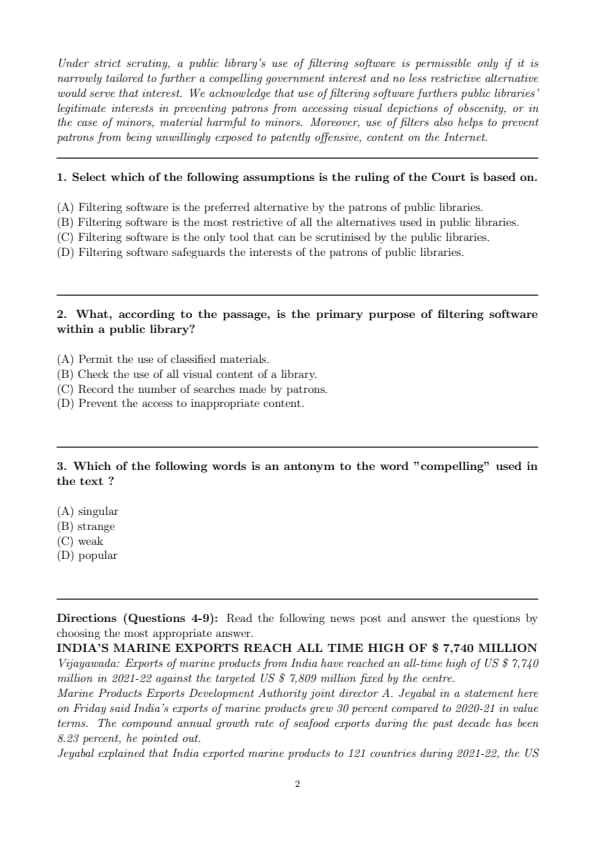
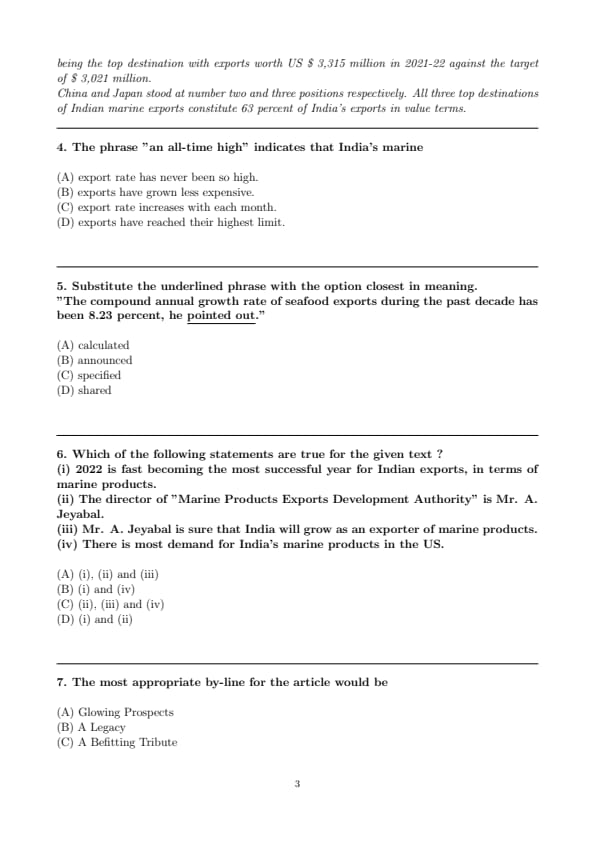
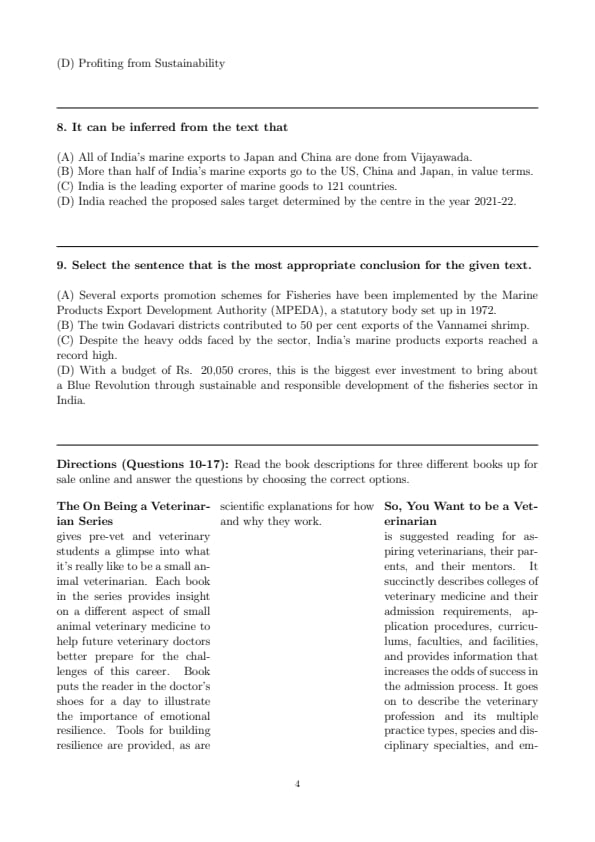


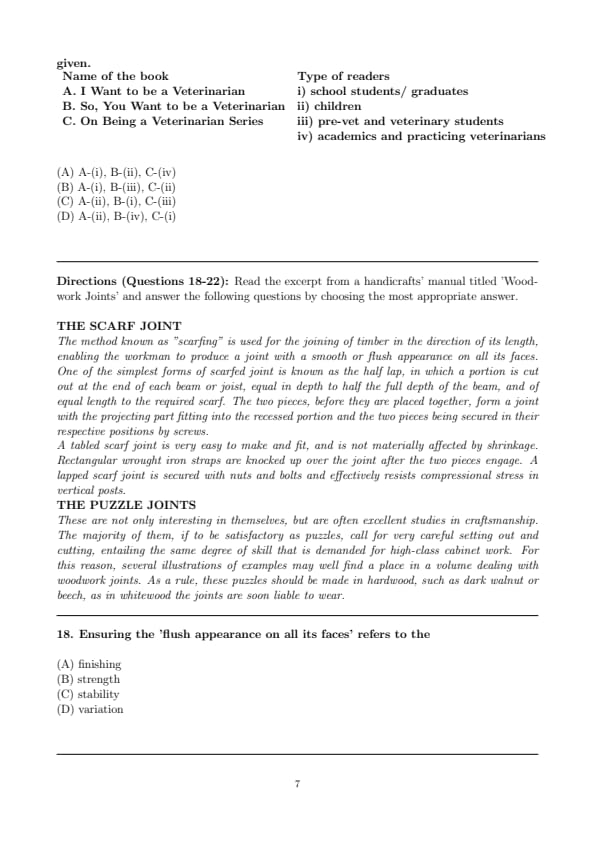

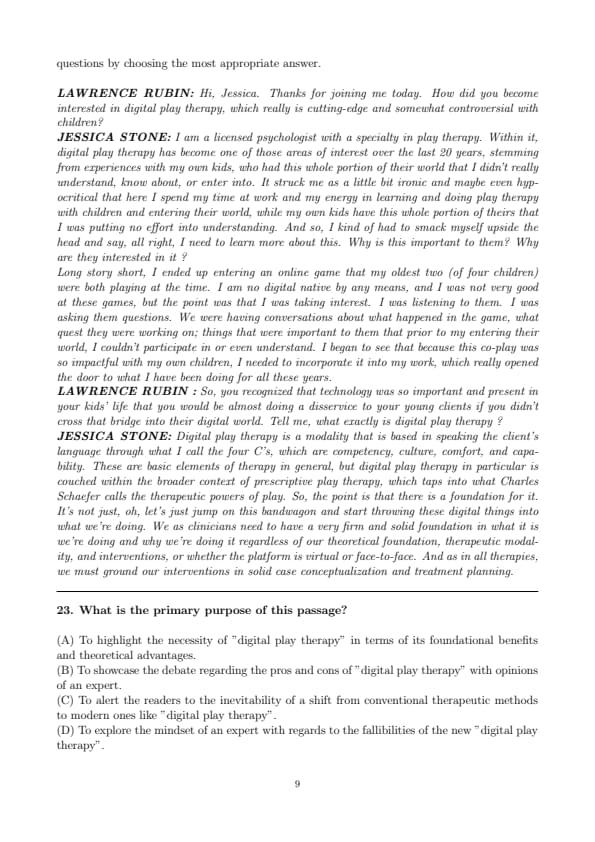
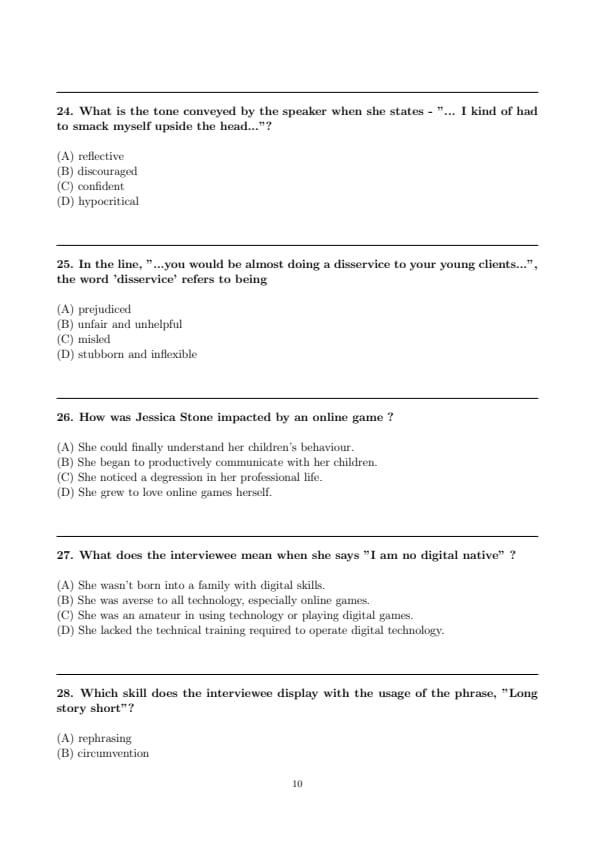
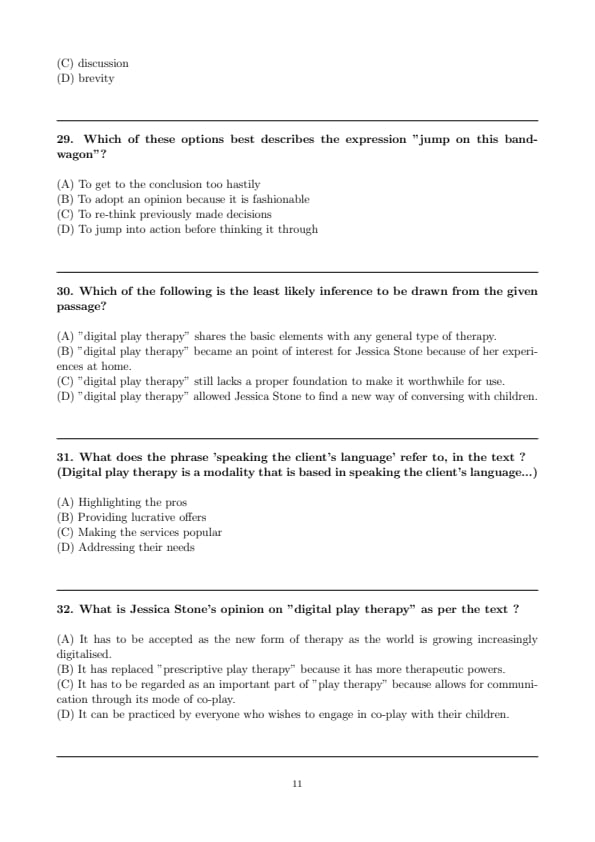
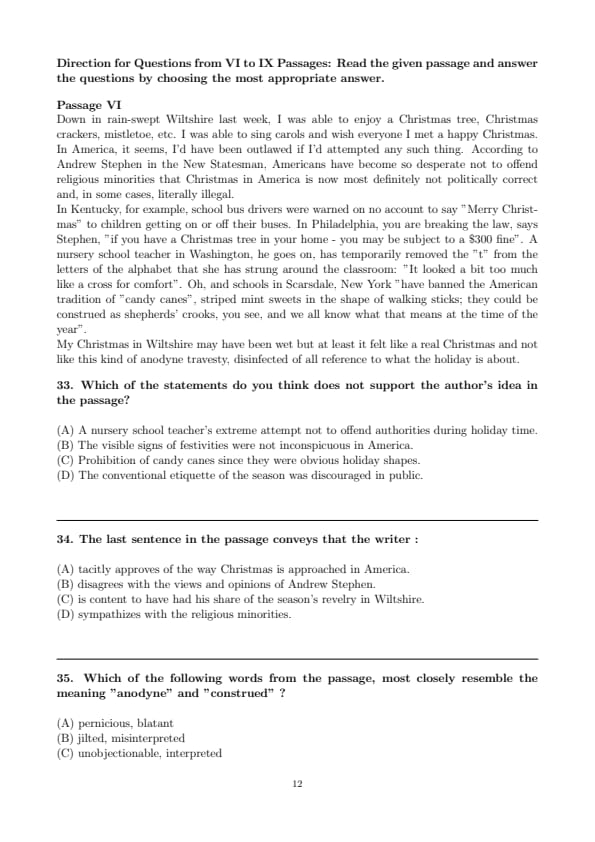
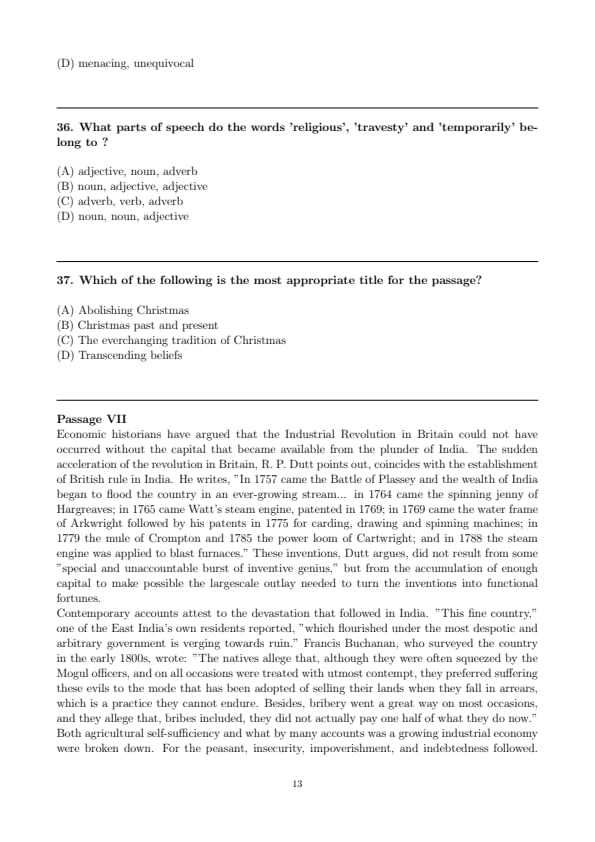


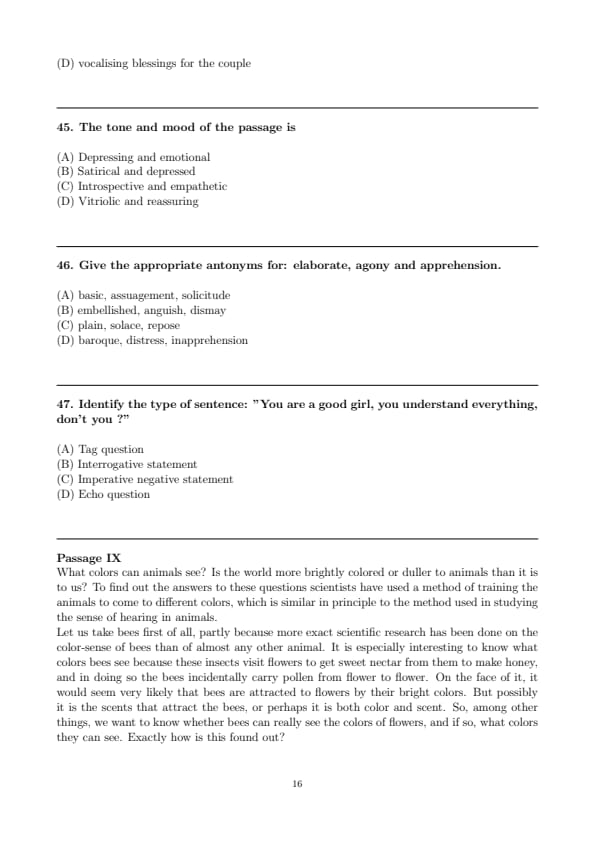
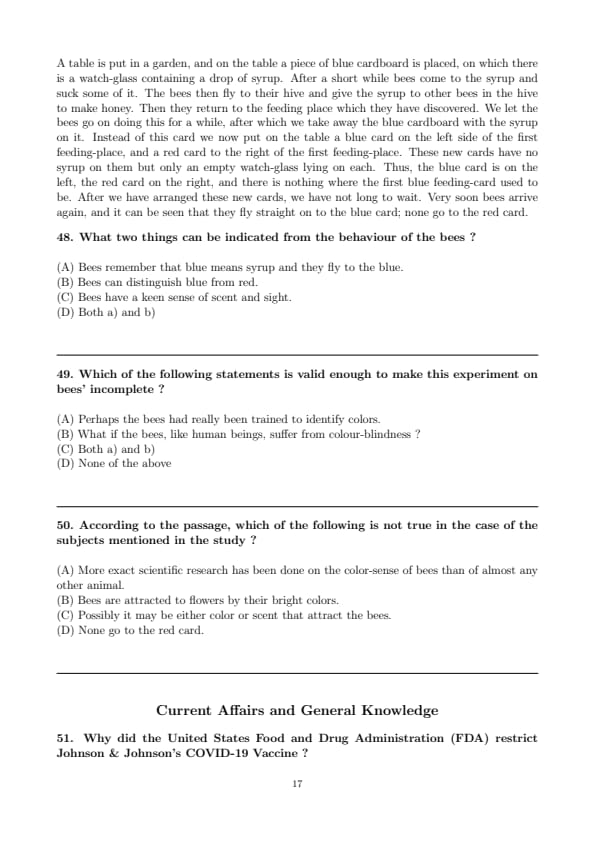
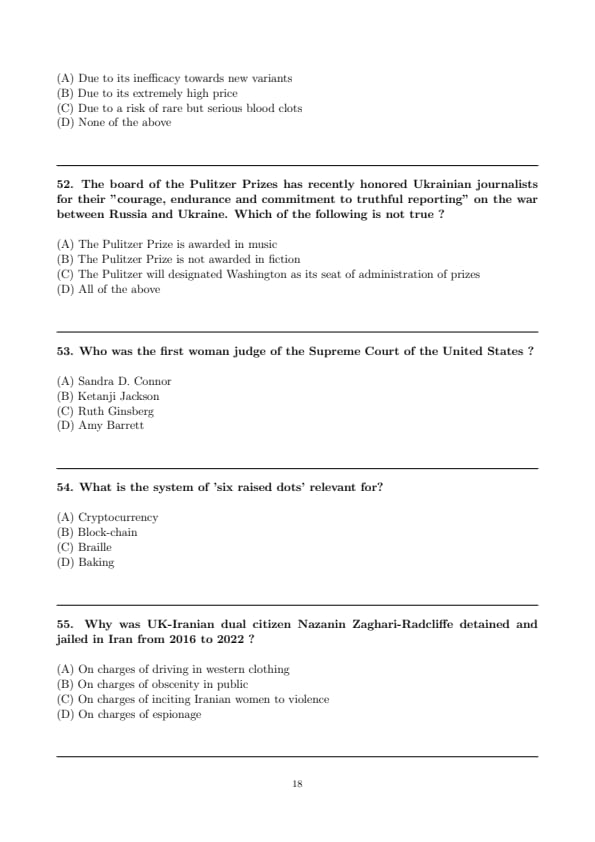
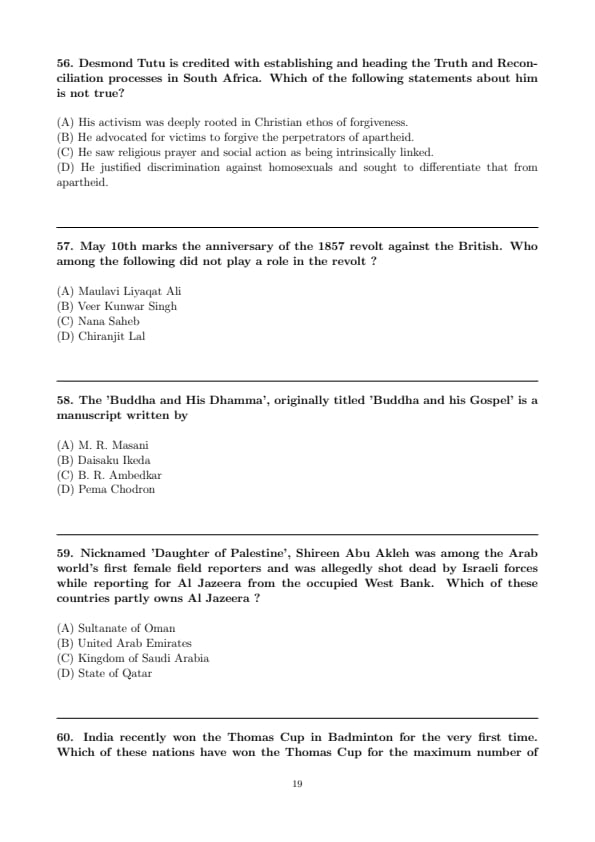
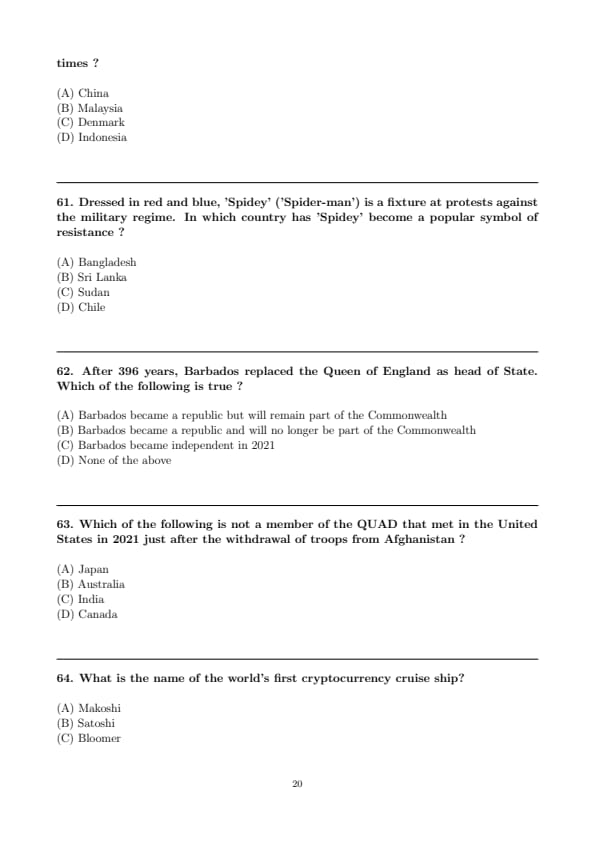
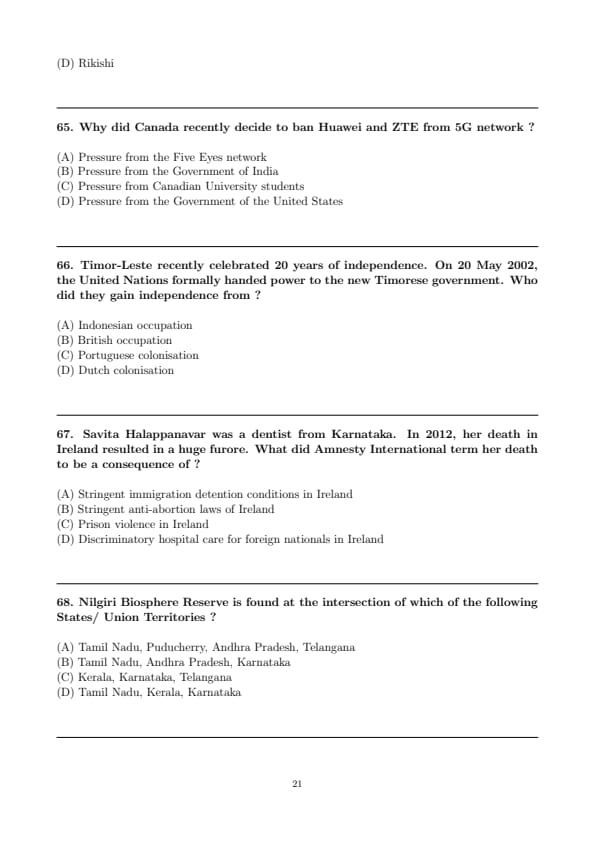
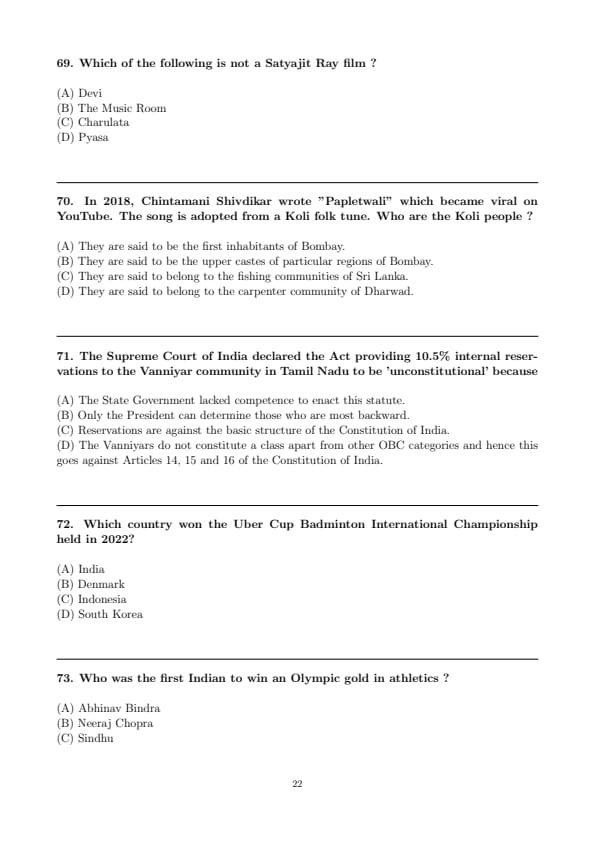
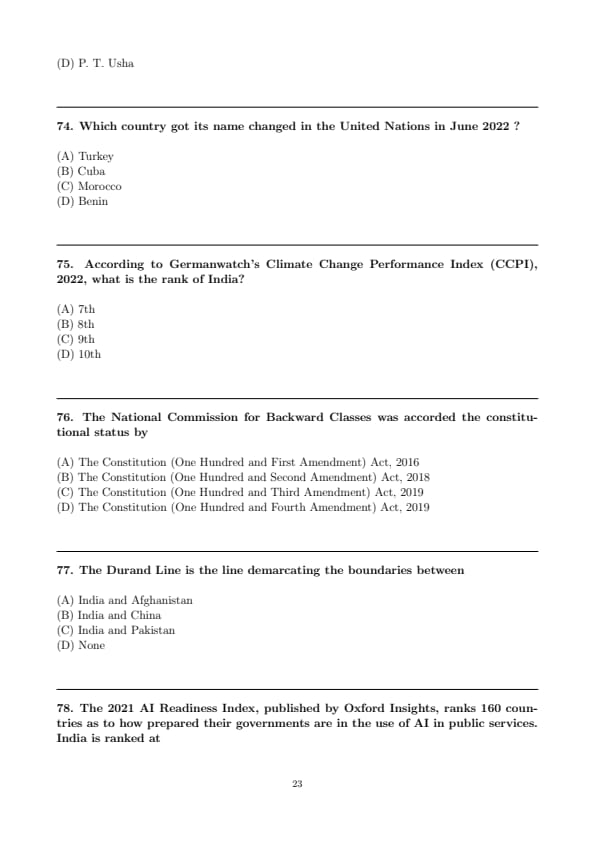
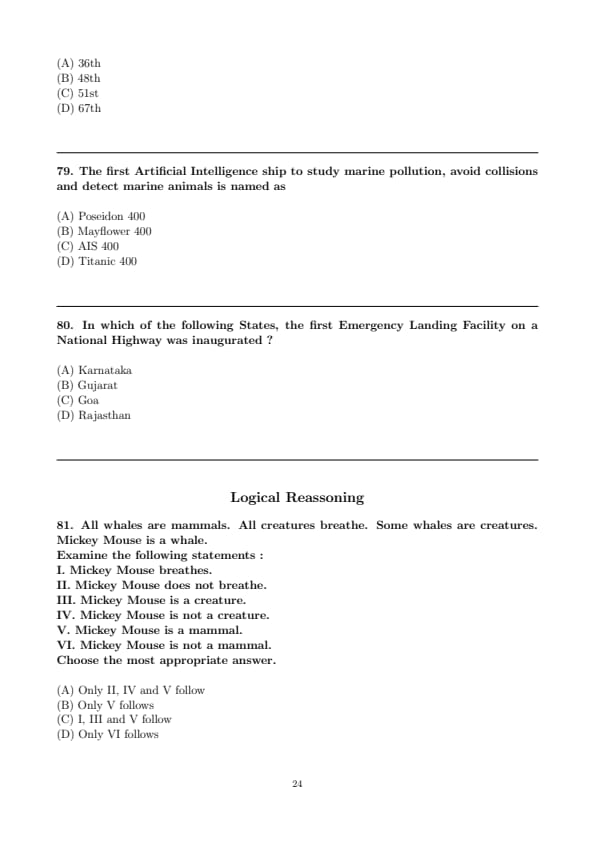


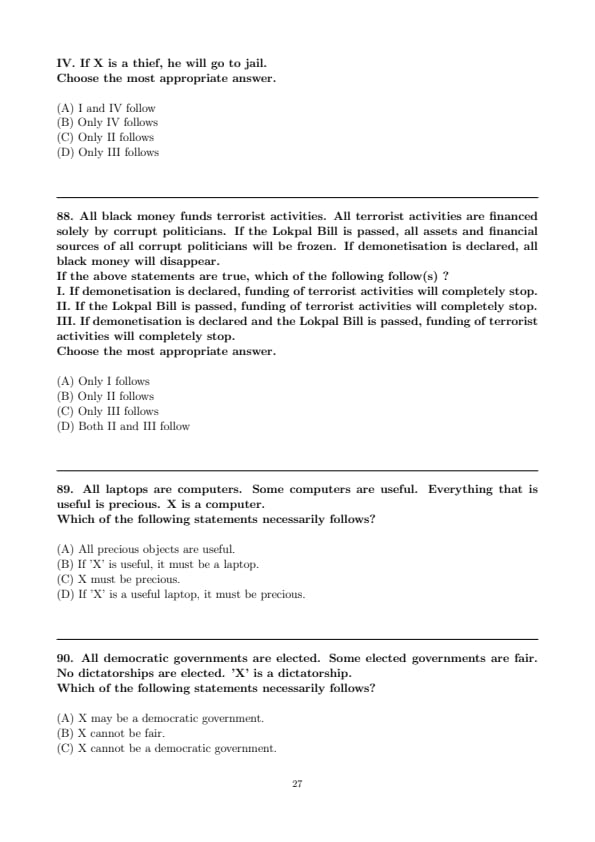
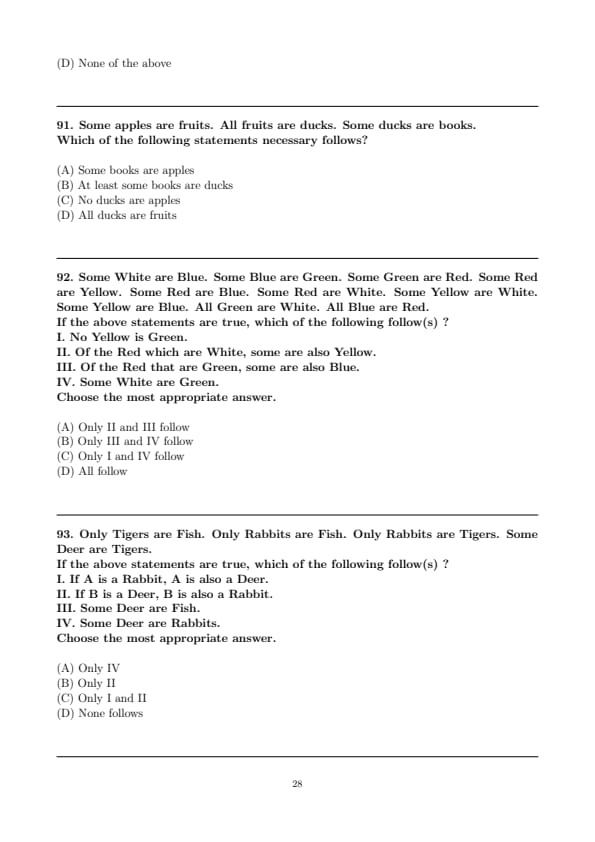
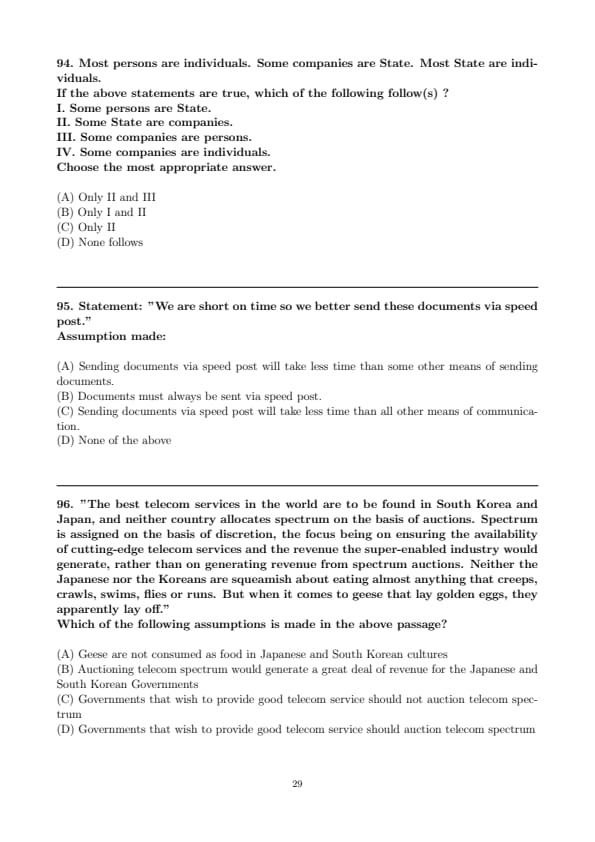
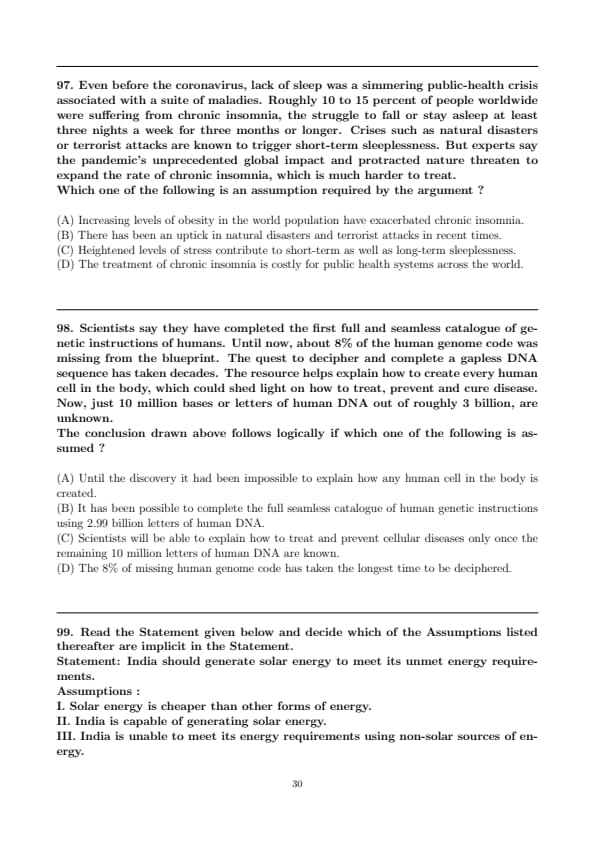
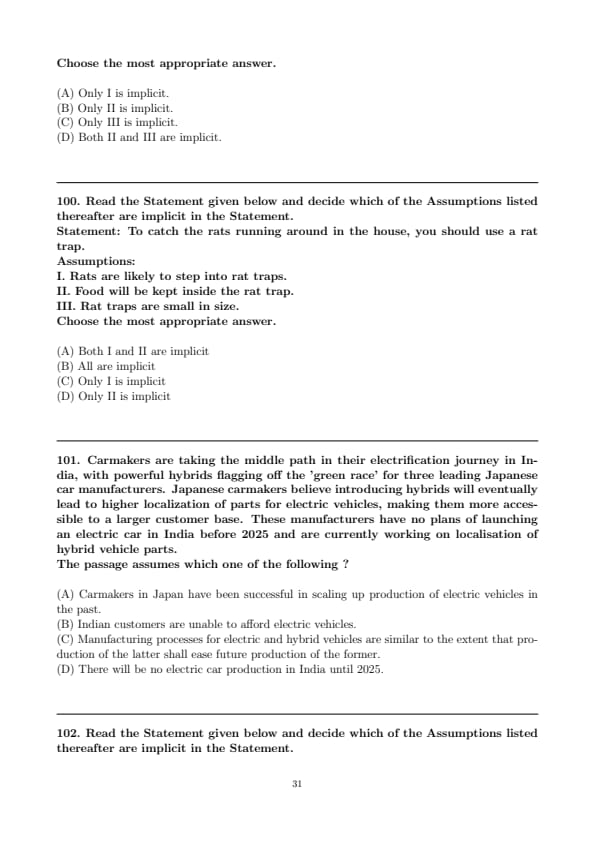
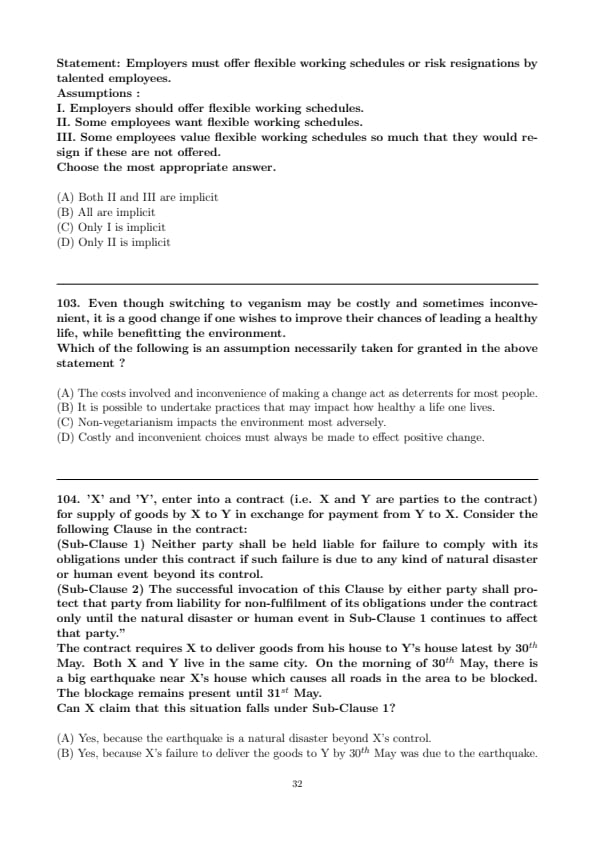
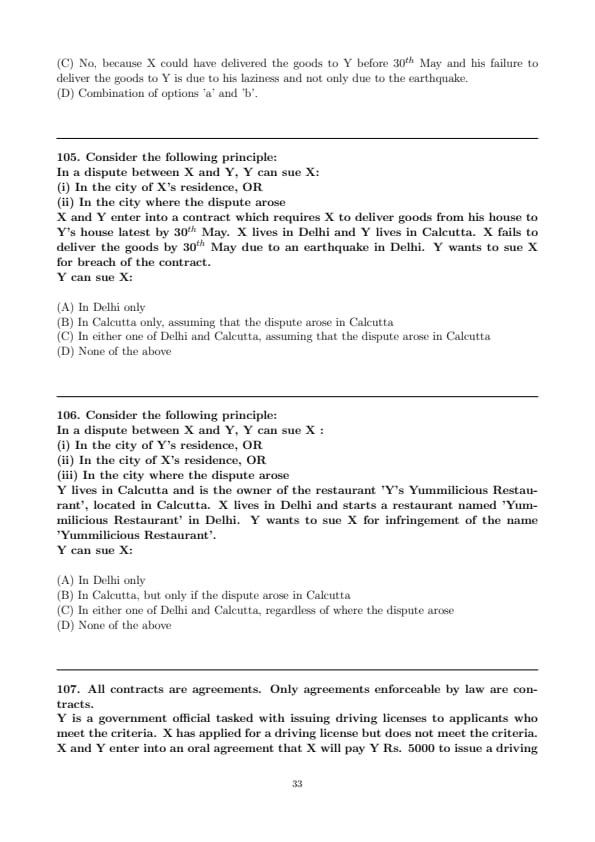
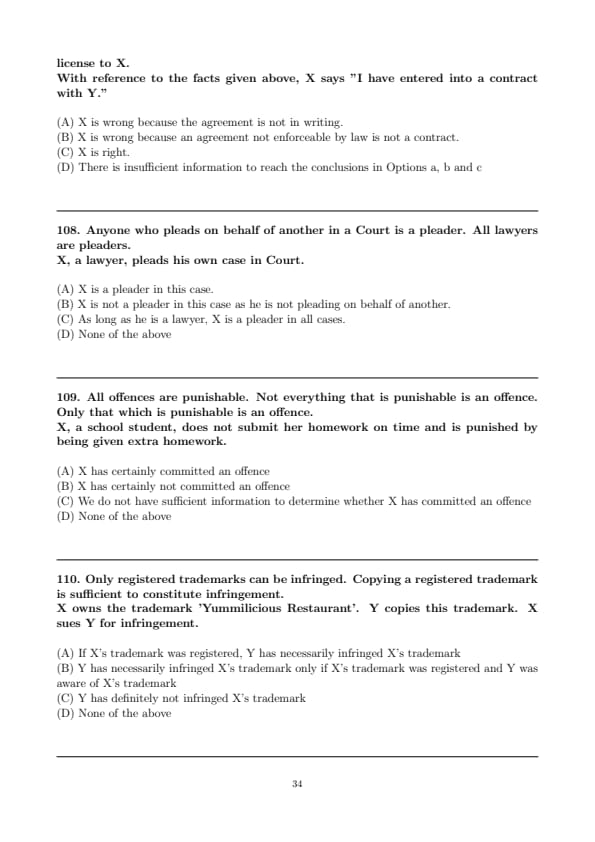


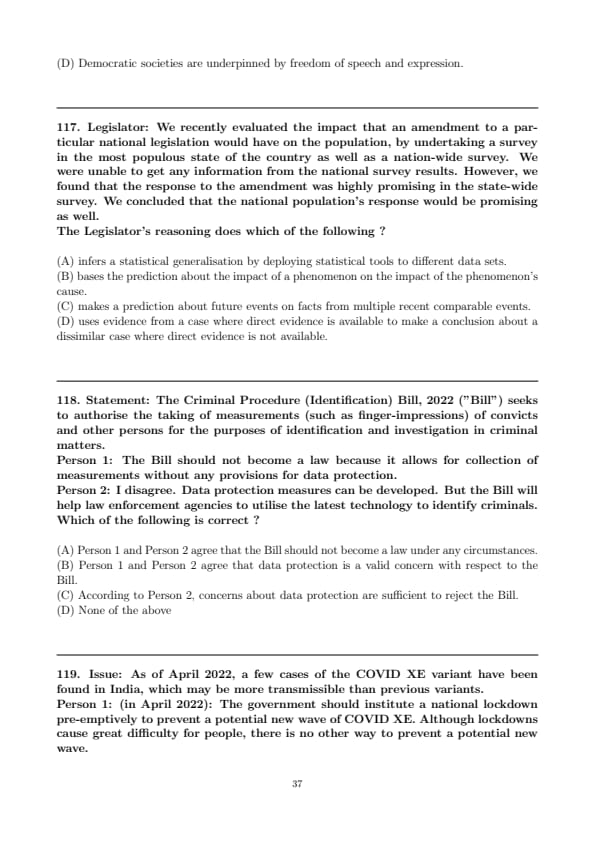

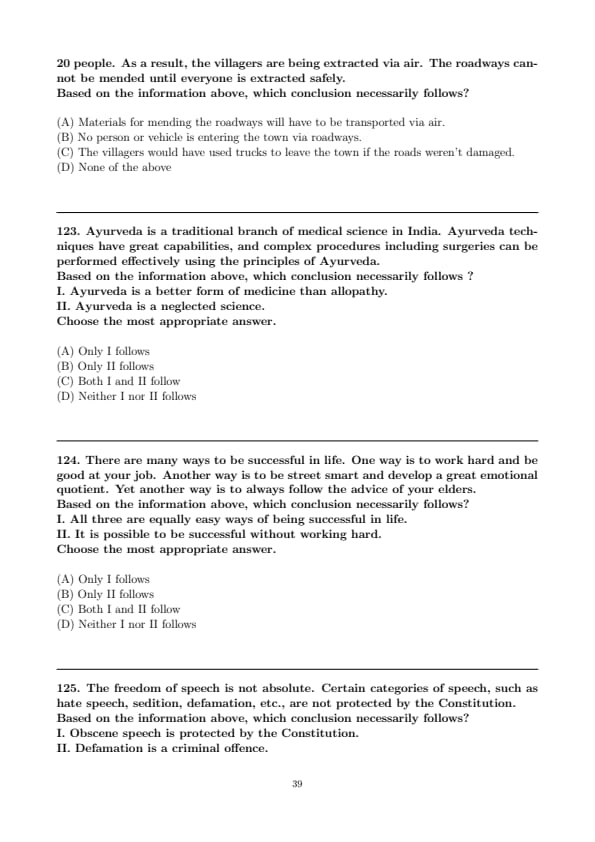
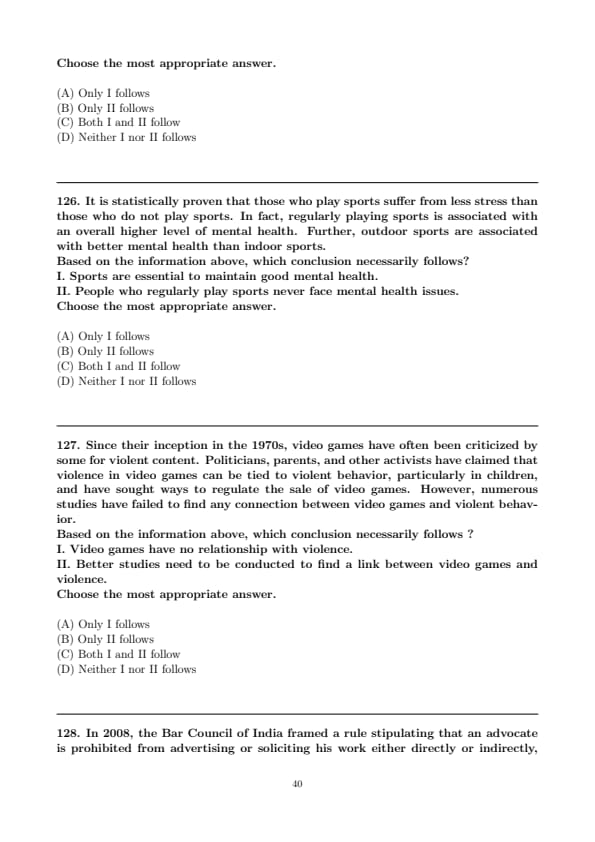
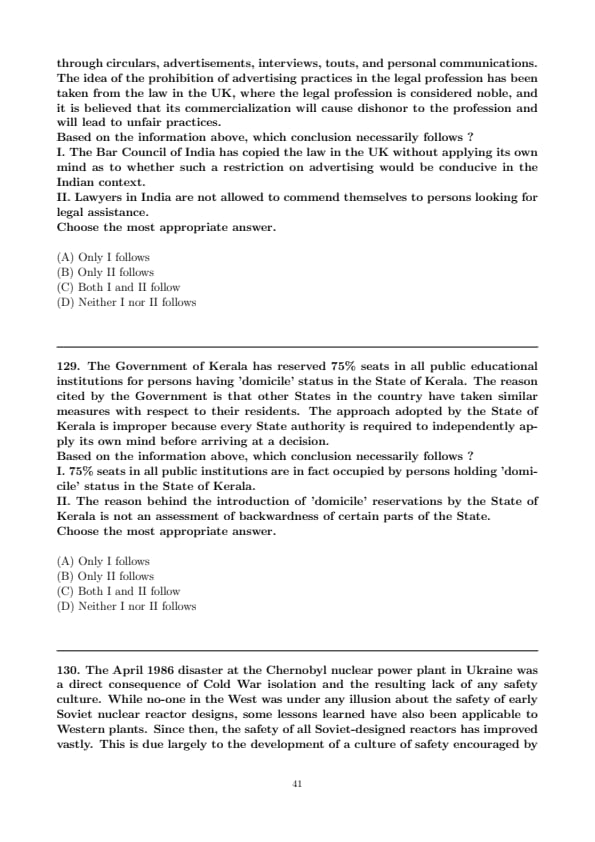

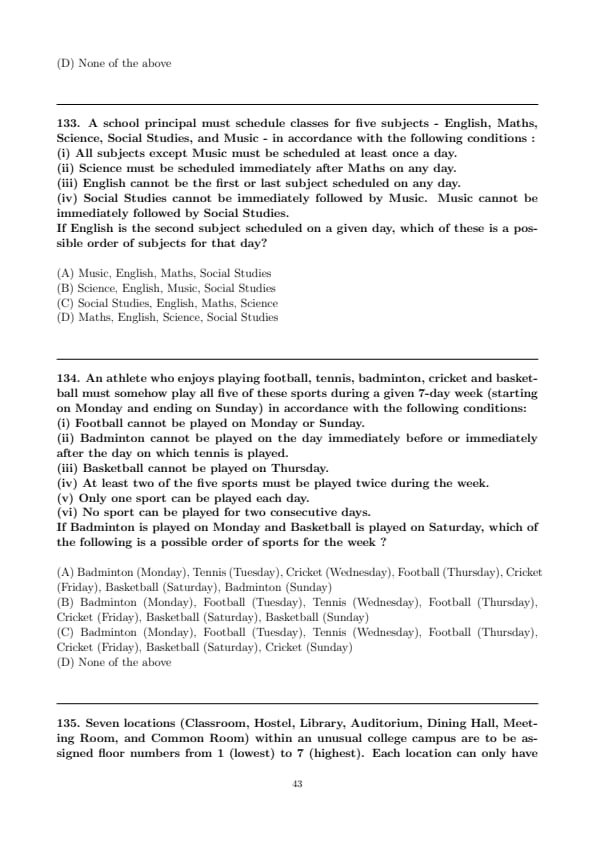


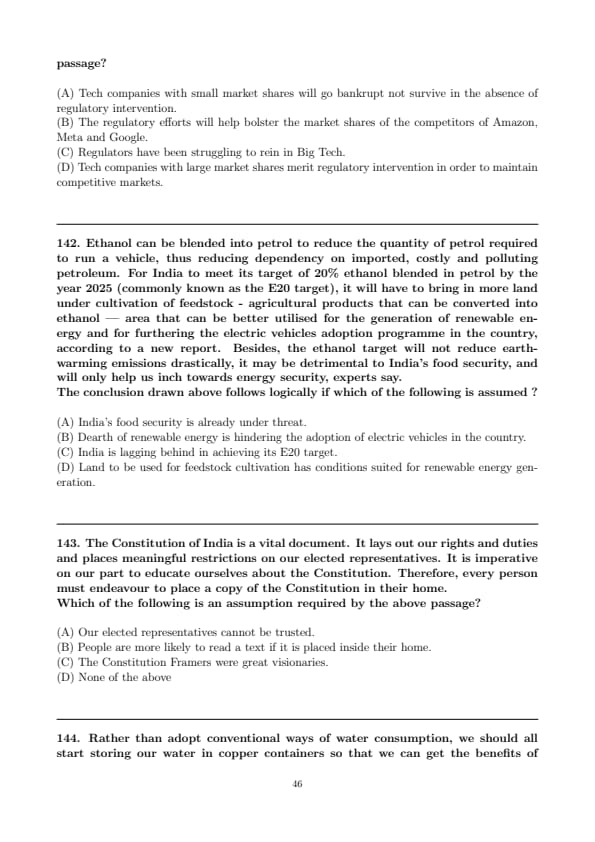
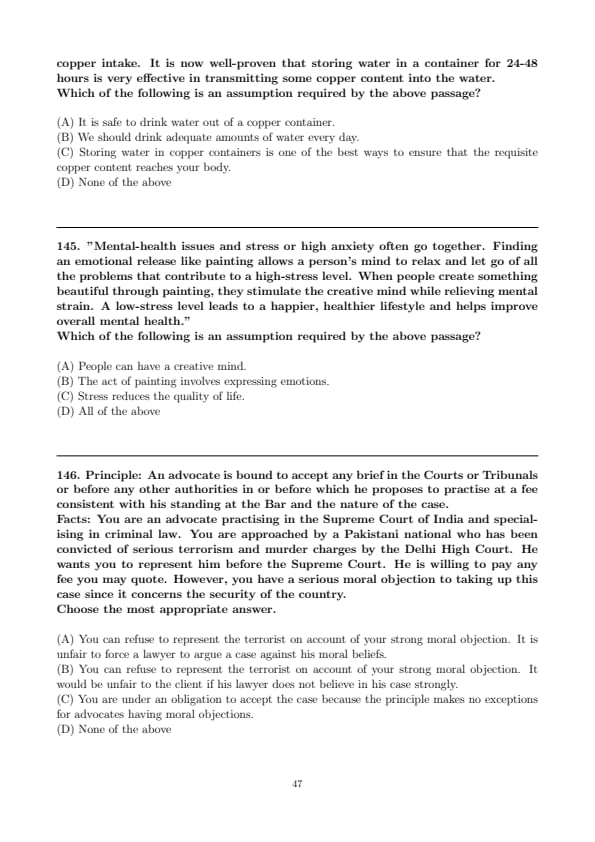
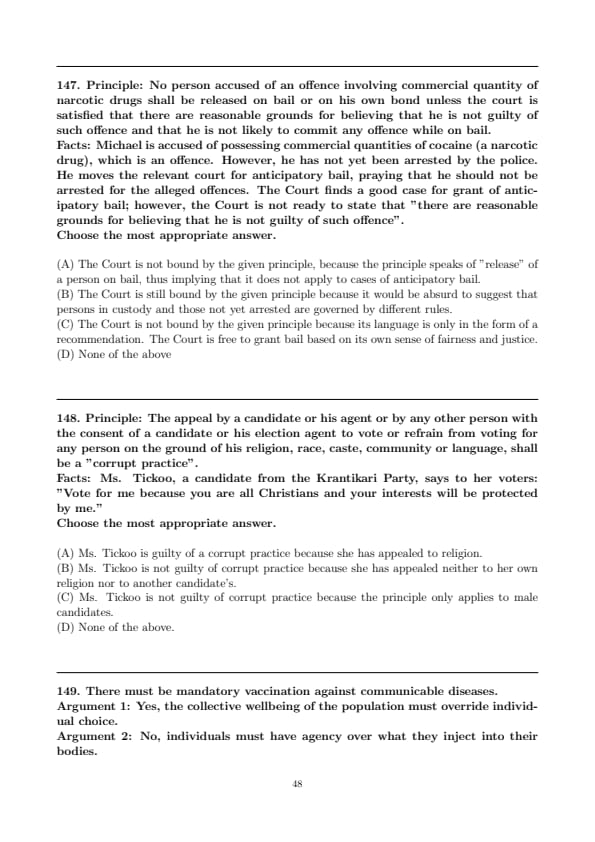




Comments